Summary
Many art historians subscribe to the notion that Greek art is superior to Roman. Roger Fry put it succinctly when he said in his book Last Lectures - "The loss of all her (Rome’s) artistic creations would make scarcely any appreciable difference to our aesthetic inheritance". The purpose of this demonstration is to show that this is a huge mistake – the better half of European art uses a form that is derived from Roman three-dimensional geometry as seen in their portrait sculpture. It was studied by Mantegna, Rembrandt and many others. The ultimate proof lies in the fact that the sculptures from the Parthenon, which most critics once believed to be the work of Phidias (the greatest Greek sculptor), turn out to be Roman replacements; almost certainly commissioned by Hadrian. The originals were certainly designed by Phidias and almost certainly communicated to his work force by means of life-casts in wax then modified (see Dionysus below (Fig. 39)). The reliefs of the south frieze which are Roman are so much more sophisticated than those on the north frieze (Greek). See the animated video in the British Museum of how the three ranks of cavalry are represented.
This makes The Elgin Marbles in the British Museum a landmark of new importance as they give the clearest demonstration of Roman superiority in the field of sculpture. Phidias has been mistakenly credited with the sophistication of Rome 570 years after his original work. This is particularly obvious comparing the horses of Helios (Greek) with Selene (Roman). That distinction would be less clear if all were returned to Greece. More sensible to leave them where they are. Roman three dimensional geometry has influenced the best of subsequent generations, best illustrated by Rembrandt.
Introduction
We are used to thinking of artists as producers of saleable objects – creators of sculptures, paintings and drawings. While this is true from the consumers angle it neglects a whole area of artistic activity which is to do with receiving; receiving from culture, from human life and nature. Figurative artists mostly spend their time and energy not as givers but as receivers. Most of the art that has been admired over the centuries has been that which observes nature as accurately as we are able. It is the mechanism of receiving nature and its general neglect that I wish to address in this essay: the form it takes is derived mainly either from Greek or Roman sculpture and the Greek has enjoyed much more attention than the Roman. We frequently hear how superior Greek art is to the Roman, yet in the prime example - The Elgin Marbles it is the unacknowledged Roman work that grasps more attention. See below PART 2 “Elgin Arguments”
In fact modern man is not that good at receiving natural phenomena; our brains run on abstract lines we have to learn certain tricks to see what is before us. Art theorists do not appreciate this problem they believe we see and reproduce what is there in front of us. They do not want to discuss the tricks they think of them as cheating. Cheating or not artists need to know how important advances in art happened. I discovered that life-casting was an important step towards the Greek miracle (around 475 BC when refined naturalism first appeared). One might think that such a challenging idea might stir the establishment to response. I published it back in 2004. No one has challenged the evidence or mentioned it since. The subject is taboo. The huge advantage of a wax cast from life over a live model is that it stays the same from hour to hour and from year to year. You can clothe it in fabric that too will not move; it can be measured assessed and copied for as long as it is needed.
Wax is a modellable material. It is malleable, cuttable and weldable. It can be adjusted to any pose. I put the first appearance of this use of casts to design work at Olympia (c. 480 BC) (Fig.1)
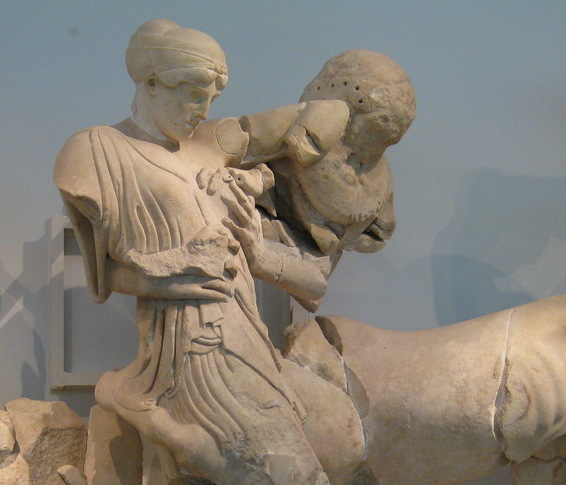
Fig. 1 - Detail West Pediment of the Temple of Apollo, Olympia. All of the figures are life size except the figure of Apollo.
I can only prove it however, with the Bronzes of Riace (Fig. 2) perhaps ten years later. A hollow wax cast is a necessary step towards a bronze casting by the lost wax process used for the Bronzes of Riace.
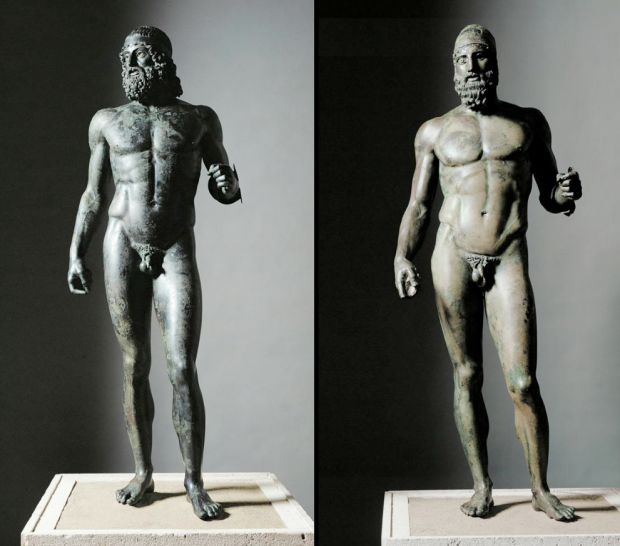
Fig. 2 - Riace Bronzes 6'6"
The same hollow wax would help carvers in their initial design. As things stand at the moment we have no idea how Phidias and others transmitted their ideas to the work-force, who carried them out so brilliantly. Wax is by far the most feasible material to use and life-casting the most economic in effort.
I start from the assumption that the mind of Man has changed as the huge convenience of language and number were developed. Our minds became dominated by abstractions and those abstractions have driven out the earlier images remembered from our sense of sight, such as we find in most cave-paintings. (Fig. 3)
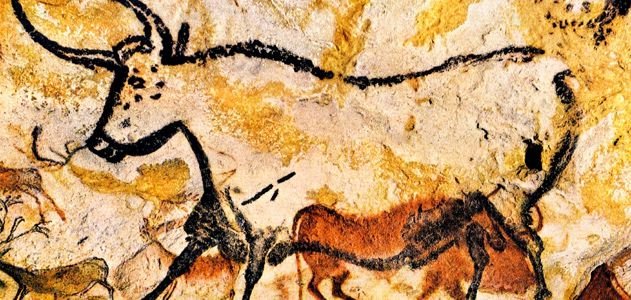
Fig. 3 - Cave painting of a bull, Lascaux, France - prehistoric
These abstractions from around 900 BC (Fig. 4) show the abstract state of mind before the Greek awakening.
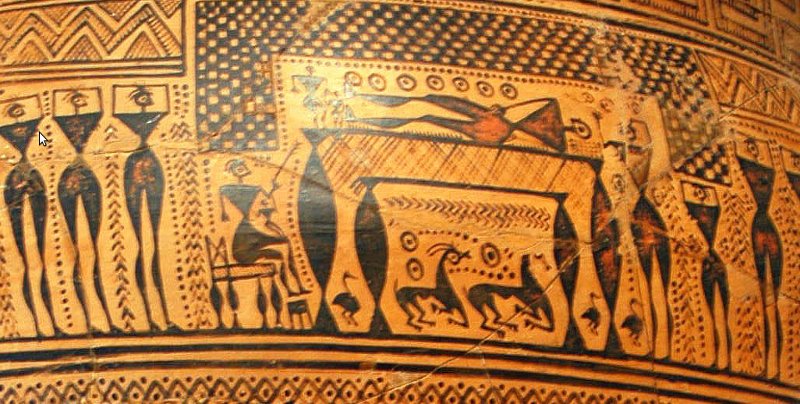
Fig. 4 - Detail of geometric vase from British Museum c. 730 BC
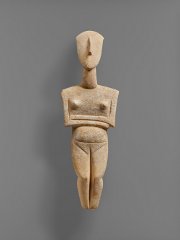 Even now beginners in drawing have to learn various tricks in order to see what is there in front of them. We learn to look at flat pattern or the space between the forms in order to trick our minds into seeing what is truly there. The foreshortening of thigh or calf seen from a particular point of view is often overlooked due to our knowledge of how long a calf or thigh truly is. Foreknowledge can block-out direct experience.
Even now beginners in drawing have to learn various tricks in order to see what is there in front of them. We learn to look at flat pattern or the space between the forms in order to trick our minds into seeing what is truly there. The foreshortening of thigh or calf seen from a particular point of view is often overlooked due to our knowledge of how long a calf or thigh truly is. Foreknowledge can block-out direct experience.
My belief is that art is a way of bridging the gap between the abstract nature of our mind and the richness of nature: what we see but do not register in the real world. I do not subscribe to the current preference for fantasy. We need all the cunning we can muster to see life truly; as we rush towards the extinction of all life on Earth we need people who can see where we are and what we need to do about it. Our art of fantasy is entirely inappropriate to the age, we need realism as never before but the traditions of art history prefer ideal beauty and invention.
In talking about Roman geometry I am describing the art of the past in a slightly novel way but it is a way that artists have followed instinctively for centuries. It is the way that follows the practice of great artists not the words of the great critics. It is also a way that allows us to distinguish quality, between what is poor from good and the better from the best,both on a physical level and on the level of psychology. That may sound elitist but without it art decays and with it psychological insight.. It is more or less agreed that the quality of connoisseurship has been in decline in the west for a century. See museums of modern art for confirmation - link to Wolfflin and Fake Rembrandt on YouTube.
Most artists would name Rembrandt as the most important old master to their way of thinking. Yet his way of drawing or receiving hardly figures in books on drawing Fig. 5.
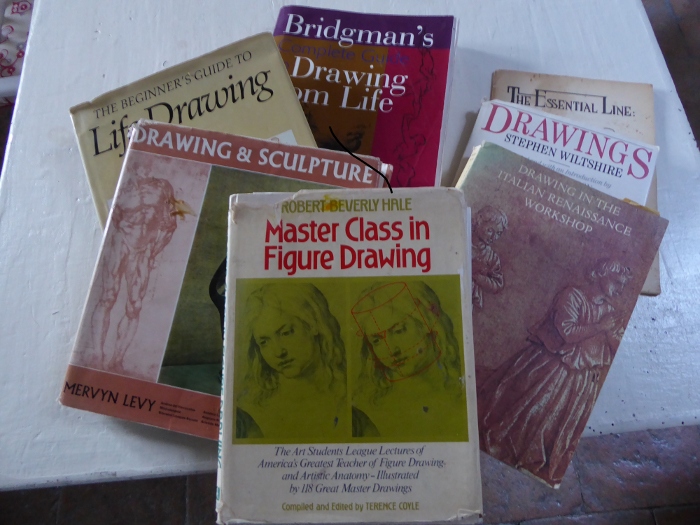
Fig. 5 - Books on drawing.
In this well used book, Master Class with many splendid examples, there is but one Rembrandt drawing (Diana Fig. 6) and that one is not one that I would choose to talk about though it does represent a particular characteristic of Rembrandt as an artist - that is his insistence on truth before beauty.

Fig. 6 - Rabmrandt's Diana
Bridgeman's book Drawing from Life (Fig. 5) refers to block construction, which is three dimensional geometry, but all the rest rely on the rounded forms derived from Greek sculpture (Fig. 7).
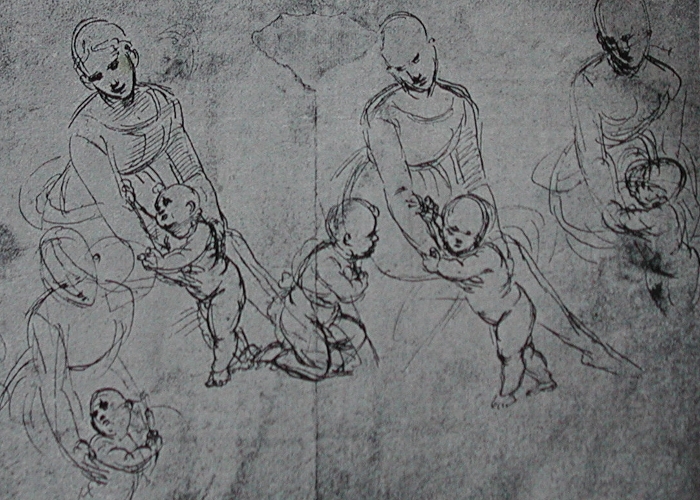
Fig. 7 - Raphael's drawing of The Madonna and Child - The Madonna almost certainly observed from a lay figure.
Rembrandt was one of many artists who used Roman form. He actually owned thirty Roman portrait busts and he studied them intensively. We know from his inventory that he filled two books with drawings from them and those studies have left a mark on everything he touches (Fig. 8).

Fig. 8 - Rembrandt's Aristotle with a Bust of Homer
Unfortunately those books have been lost but three dimensional geometry is his trademark and he gets that mainly from his study of Roman sculpture. Rembrandt scholars concentrate on the quality of his lines and seem blind to the volumes moving in space that promote Rembrandt in my estimation to the greatest of all draftsman because he saw how the human spirit expresses itself in the physical world more clearly than any before or since.
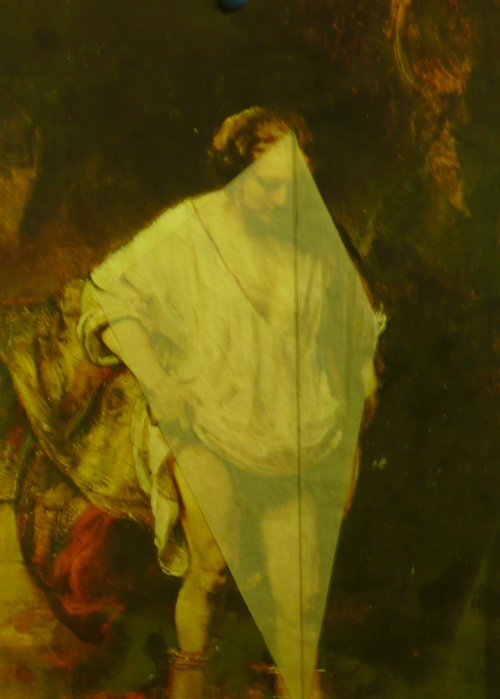
Fig. 9 - A Woman Bathing in a Stream by Rembrandt, with his use of 3D geometry explained by seeing the vertical line as the near corner of the block in which a sculptor might carve the figure, her elbows touch the two sides
Rembrandt was by no means the first to use this geometry but he is by far the most original and innovative of the users because he included space in his geometry (Fig. 9), where others used it to describe solids only. Among the artists who used Roman geometry before Rembrandt I would name Masaccio, Mantegna, Holbein and after Rembrandt particularly Degas and Giacometti (Fig. 10), but many others used geometry on occasion.
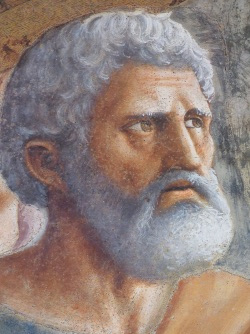
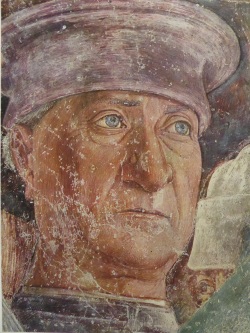
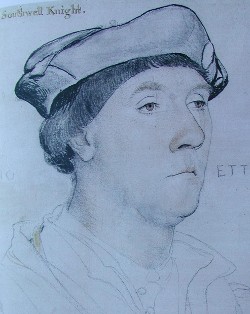
Masaccio
Mantegna
Holbein
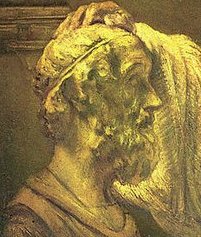
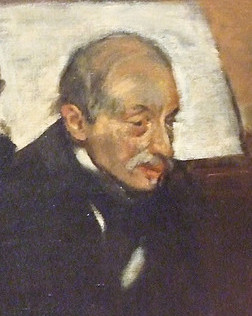
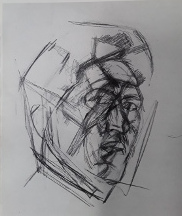
Rembrandt
Degas
Giacometti
Fig. 10 - Examples of several artists' use of Roman geometry.
See Nigel Konstam's analysis of the geometry of bust of Hadrian on Youtube (First published in Apollo in Aug 1972)
The importance of Rembrandt's use of space is that he sees emotional relationships (primarily in the space relationship between his actors) in a way that no artist had done before. It works wonders and laid the foundations for today’s study of body language.
Raphael is the most successful of the users of the Greek form. Let us compare Raphael’s groups with Rembrandt's in order to show the major differences between the two approaches. Raphael uses Greek forms as seen in the lay-figure (Fig. 11). The lay figure is very much based on the shapes of classical Greek sculpture.
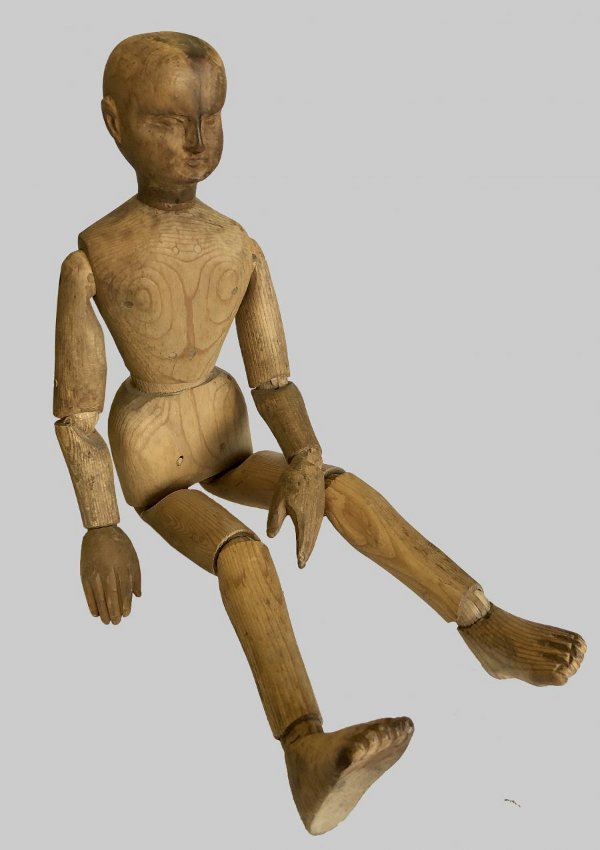
Fig. 11 - Example of a lay figure, these rounded forms are derived from early Greek sculpture.
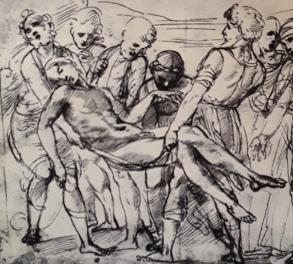
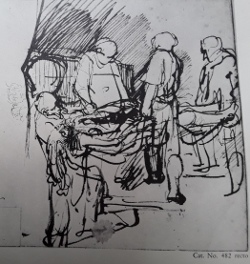
Fig. 12 - Raphael's Entombment
Fig. 13 - Rembrandt's Entombment
Raphael made studies of the single figures of the carriers pretending to carry a body with the result that he never makes a convincing group. In contrast Rembrandt's carriers are much more convincing.
In this study for Raphael’s Entombment painting (Fig. 12) we see that's the two carriers of the body of Christ are pulling in opposite directions. They are not cooperating; in Rembrandt’s much more sketchy scene (Fig. 13) all four carriers are cooperating because they were actually observed from a tableaux vivant rather than imagined. In Raphael’s case we understand the story but we cannot believe in the actions effectiveness; with Rembrandt there is no detail but as a group it holds together as a real life event. Rembrandt's observation of space is what allows him to create real drama, gives him psychological insight and makes him an innovator of major importance.
Where Rembrandt produced groups of live models in his studio and asked them to act out the scenes. The earlier Renaissance artists used perspective and the lay-figure and were able to relate figures in wide spaces reasonably accurately (Fig. 14) but when it comes to what I call intimate space they fall apart (Fig. 15).
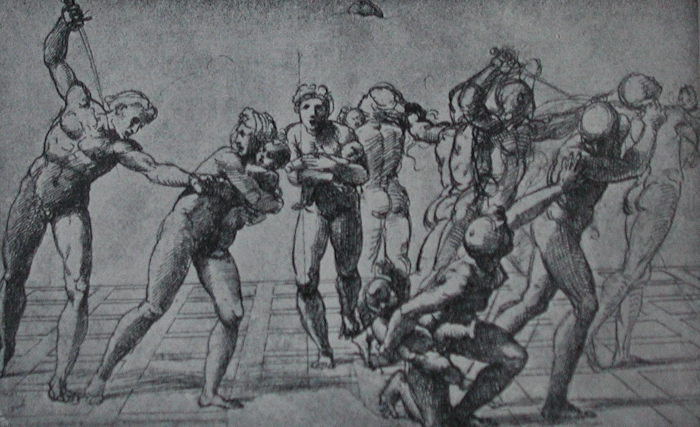
Fig. 14 - Raphael's The Massacre of the Innocents
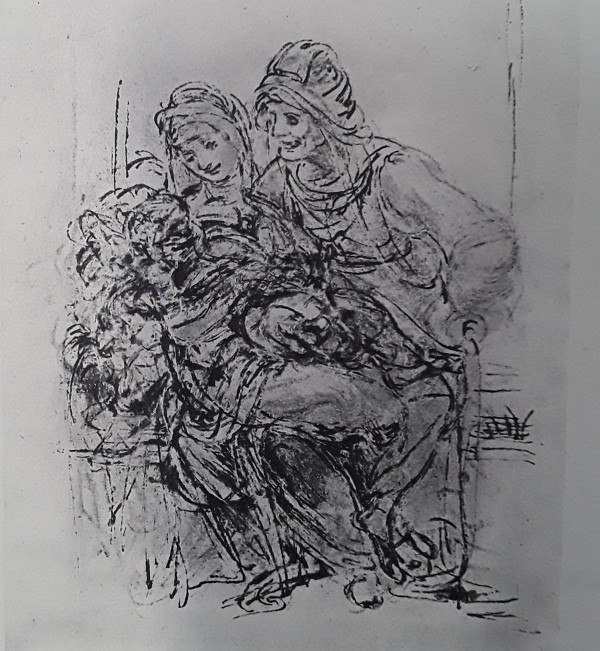
Fig. 15 - A sketch for The Virgin and Child with St Anne by Leonardo da Vinci, showing that even the arch imaginer had problems with intimate space.
This is because intimate space is almost impossible to invent. Rembrandt observed intimate space, that is crucial to our understanding of him. Compare the attempts to convey intimate space by da Vinci (Fig. 15) to the convincing intimacy of Rembrandt's David on his Deathbed (Fig. 16)

Fig. 16 - Rembrandt's David on his Deathbed. The relationship between David and Solomon is very much as depicted in the bible.
See this video for further elaboration.
If we now look at his drawing of The Unworthy Wedding Guest (Fig. 17) we see again little detail of hands or other anatomy but we can read the emotions that stir in this man about to jump to his feet because the pose is seen as a whole and with such accuracy. Looking at his companion across the table we see curiosity but not the same determination to join the fray.
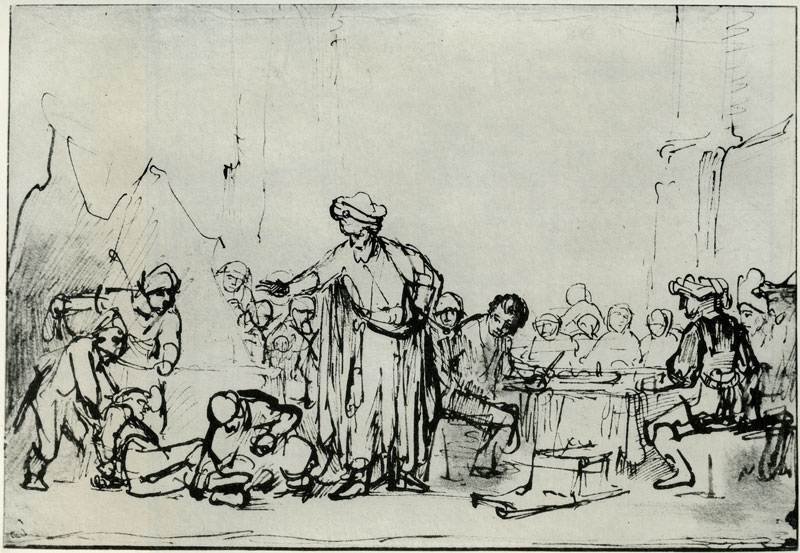
Fig. 17 - The Unworthy Wedding Guest by Rembrandt, see this video for more.
I have proved over and over again that these scenes from Rembrandt were observed from life; his contemporaries tell us the same. But the experts insist that they are created from an inner vision: imagined. This is a huge mistake and has led the disastrous state of Rembrandt scholarship and leads artists since to expect miracles from their own imagination (they are generally disappointed).
The proof of the groups of living models is geometric. Rembrandt made a habit of drawing reality and its reflection, sometimes in the same drawing (Fig. 18) at other times in separate drawings or paintings (Fig. 19). I have found Rembrandt using mirror images nearly 100 times in his drawings not counting the self-portraits. This Youtube video provides an in depth look into Adoration of the Shepheards, a prime example of his use of mirrors.
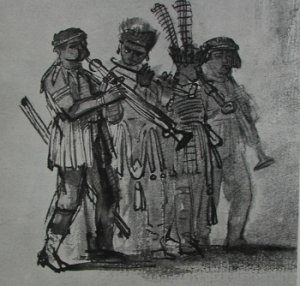
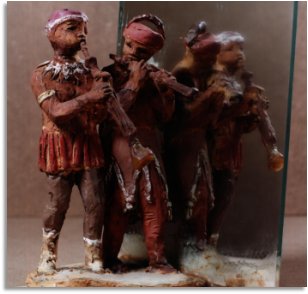
Fig. 18 - Rembrandt sketch of four musicians (left), showing his use of live models and mirrors (right). The figures can be identified as live models not true musicians as they don't know how to hold their instruments!



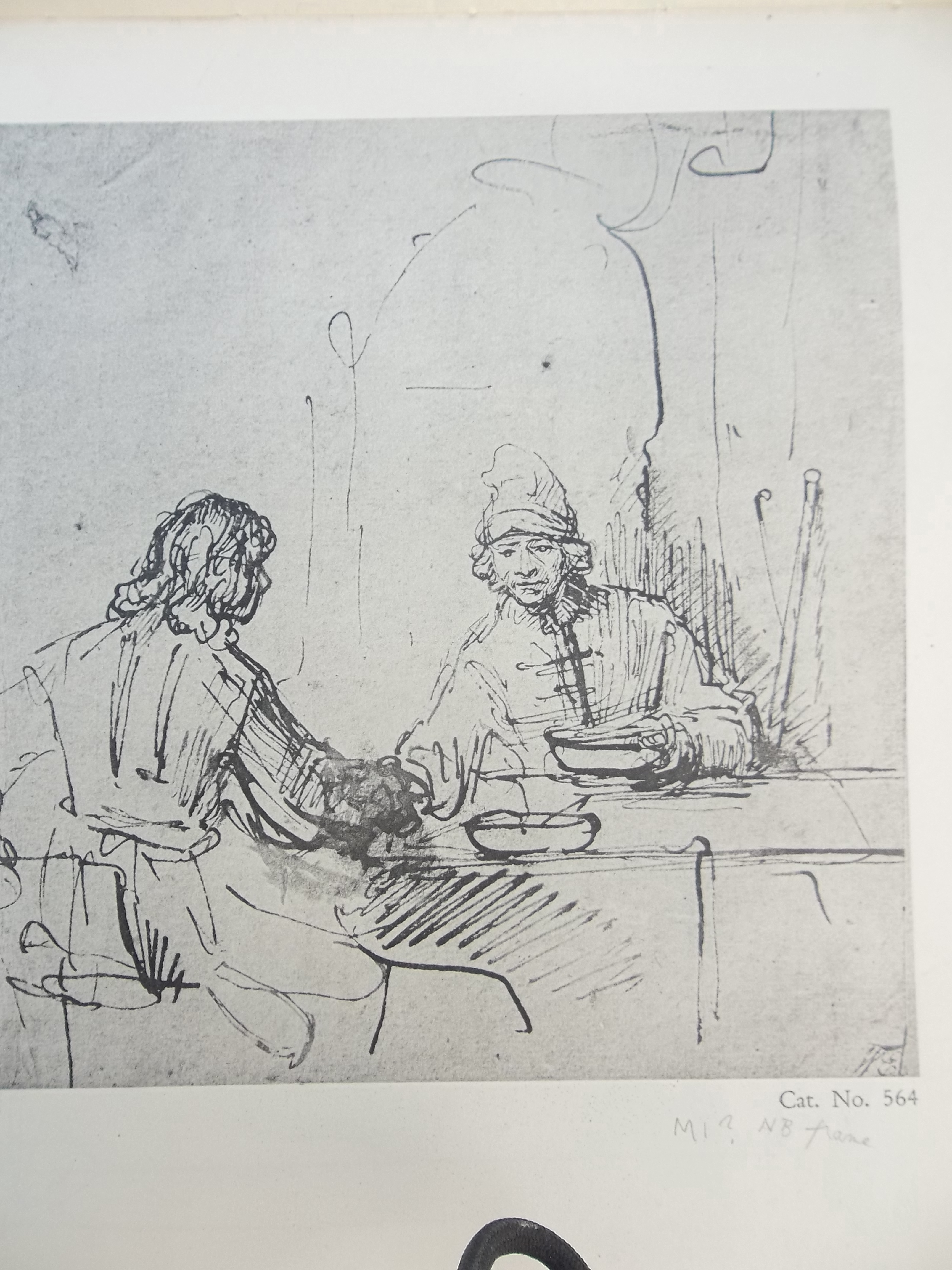
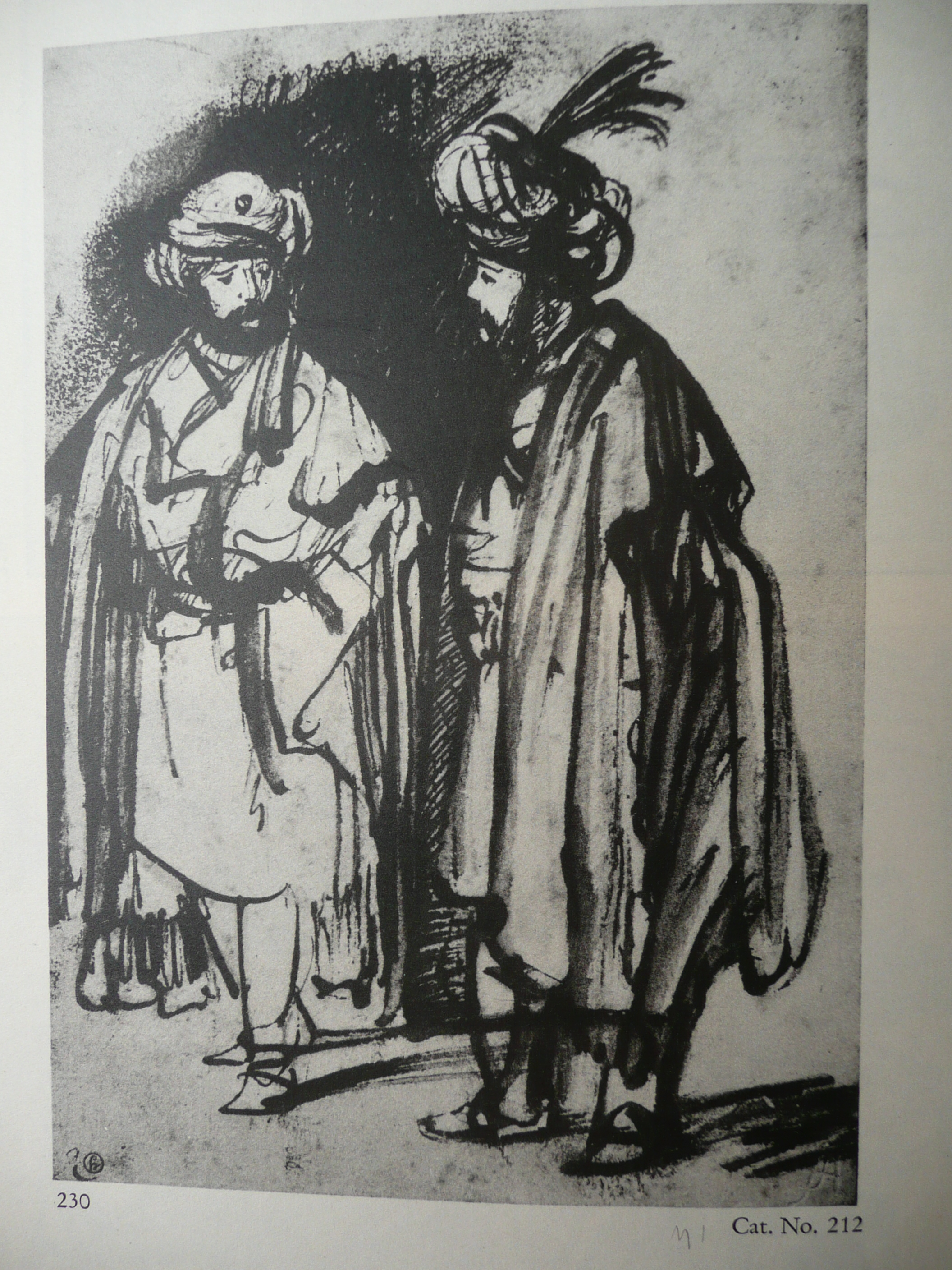
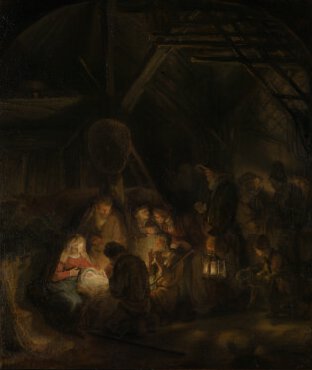
Fig. 19 - More examples of Rembrandt's use of mirrors, including the painting Adoration of the Shepherds ( see Youtube link above)
It is important to realise that mirror images are not the same as print images in which you get a reversal of a two-dimensional image. A mirror image is a reversal of a different point of view of the same three-dimensional group. Link to mirror images
With these few examples I hope I have convinced you that Rembrandt’s observation is an important advance on Raphael’s invention. I think this distinction between observation and invention is true generally in art. But alas it conflicts with the theories of art experts over the centuries. Rembrandt scholars must have been aware of my discovery since February 1977 when it was published in The Burlington Magazine with the support of Prof. Sir Ernst Gombrich. It was published in Dutch a year later (Rembrandthuiskroniek vol.1. (1978)) and has been neglected or snubbed by the experts ever since. They continue with their old story in the face of evidence from Rembrandt’s contemporaries and mine which proves the contemporary accounts to be reliable. I keep YouTubing but no change.
This same refusal to look at contrary evidence has been played out in the case of Velasquez’ (Las Meninas published March 1980 The Artist Magazine) with Vermeer and is being played out today - see below - in a yet more important context – The Elgin Marbles.
The experts like Rembrandt to make “bold strokes” and he often does so, often only to make new ideas legible over his more delicate, careful drawing that preceded his final summing up. This drawing of Job and his Comforters (Fig. 20) the experts describe as a student drawing corrected by Rembrandt, a category of little interest and one that portrays Rembrandt as a savagely critical instructor, which is improbable seeing the popularity of his school. My analysis makes the work psychologically defining of Rembrandt’s courage as an explorer. I see it as Rembrandt trying a new idea over his own thoroughly successful drawing See this video for more. He left a paper trail of his explorations, which endears him to artists but experts cannot accept that a genius stumbles as he makes his way. No other artist has left so many clues of his method nor been so misunderstood as a result.
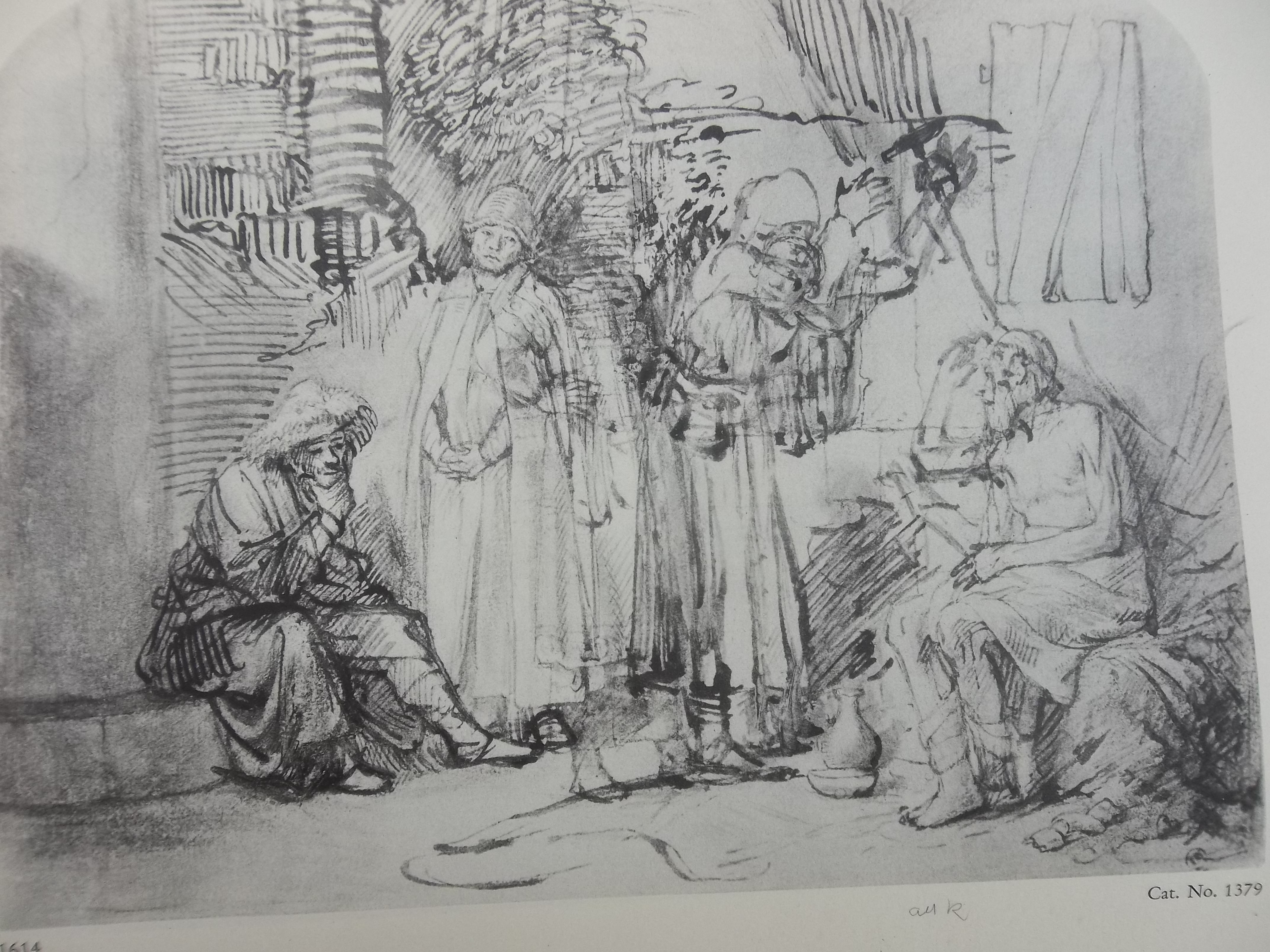
Fig. 20 - Job and his Comforters
For example, I would like to explain why I regard this rather untidy drawing(Fig. 21) as one of Rembrandt’s masterpieces. It allows us to follow Rembrandt’s creative process. I have explained this in this YouTube video.
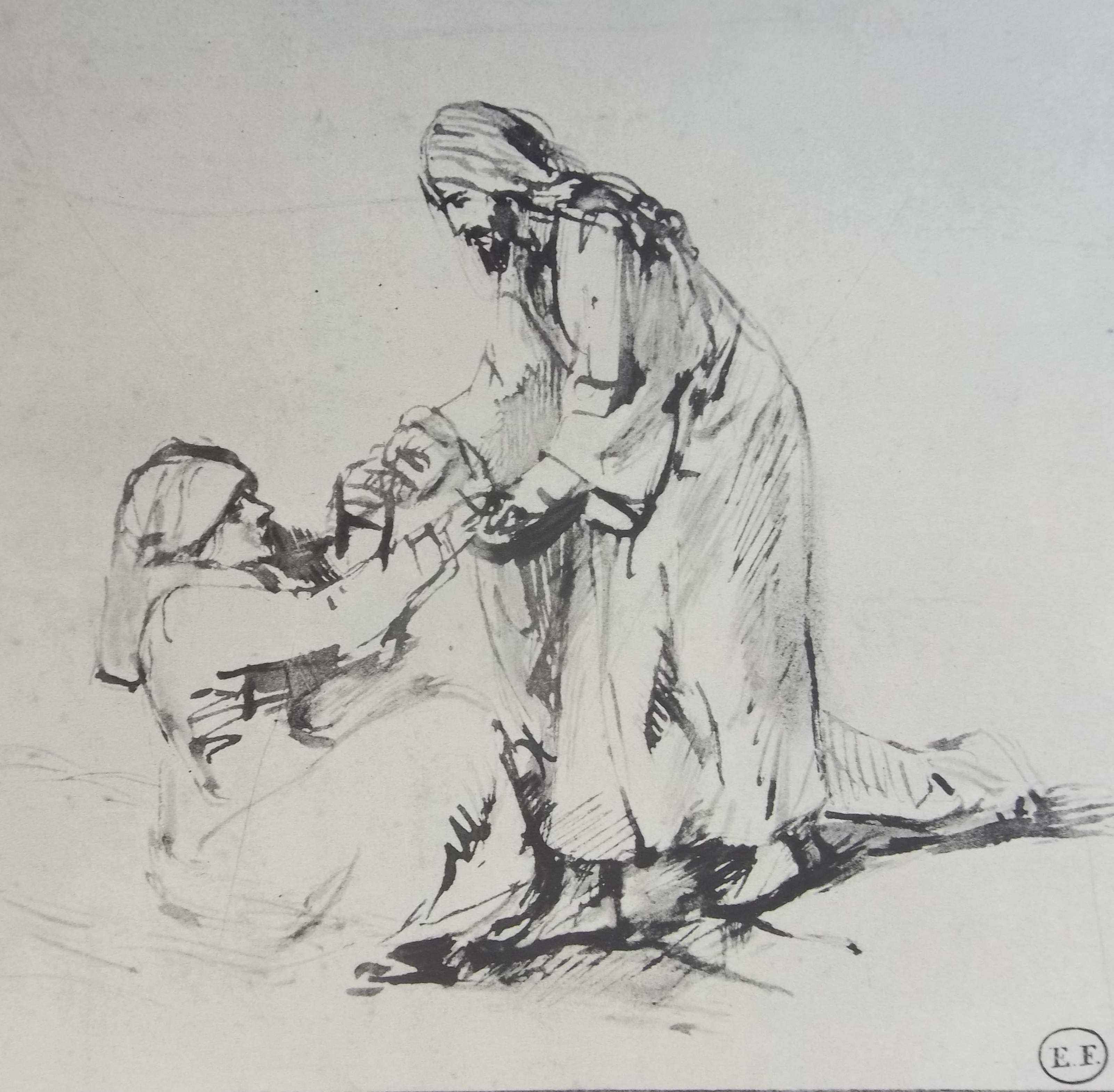
Fig. 21 - Christ Raising a Sick Woman
I have made an analysis of how the Romans copied portraits of their Emperors into stone by the use of calipers and plumb line. Please note that the following explanation is quite detailed and in depth, so I would recommend watching this YouTube video where I provide a detailed description of the procedure. I presume the original was made from the Emperor himself almost certainly in clay, which was then fired and the terracotta sent to a workshop to be copied many times. Here are a few photographs of the way in which this head of Hadrian is related to the original block from which it was carved. In the first picture (Fig. 23) we see the block after an apprentice has cut away the stone that will never be used leaving a smaller block on top of the stone for shoulders.
The second photograph (Fig. 24) shows how the final head is related to this small block, the axis of symmetry is exactly in line with the corner of the block. The axis in depth is made by joining this front corner to the one diagonally opposite. The third picture (Fig. 25) shows an egg cut within the smaller block, the sculptor would then have made a measuring boss, a point on Hadrian's central curl from which all measurements would be made. It is likely that other points would be established on his chin and the back of his head so that the turning-points of the plains could be established accurately in three dimensions.
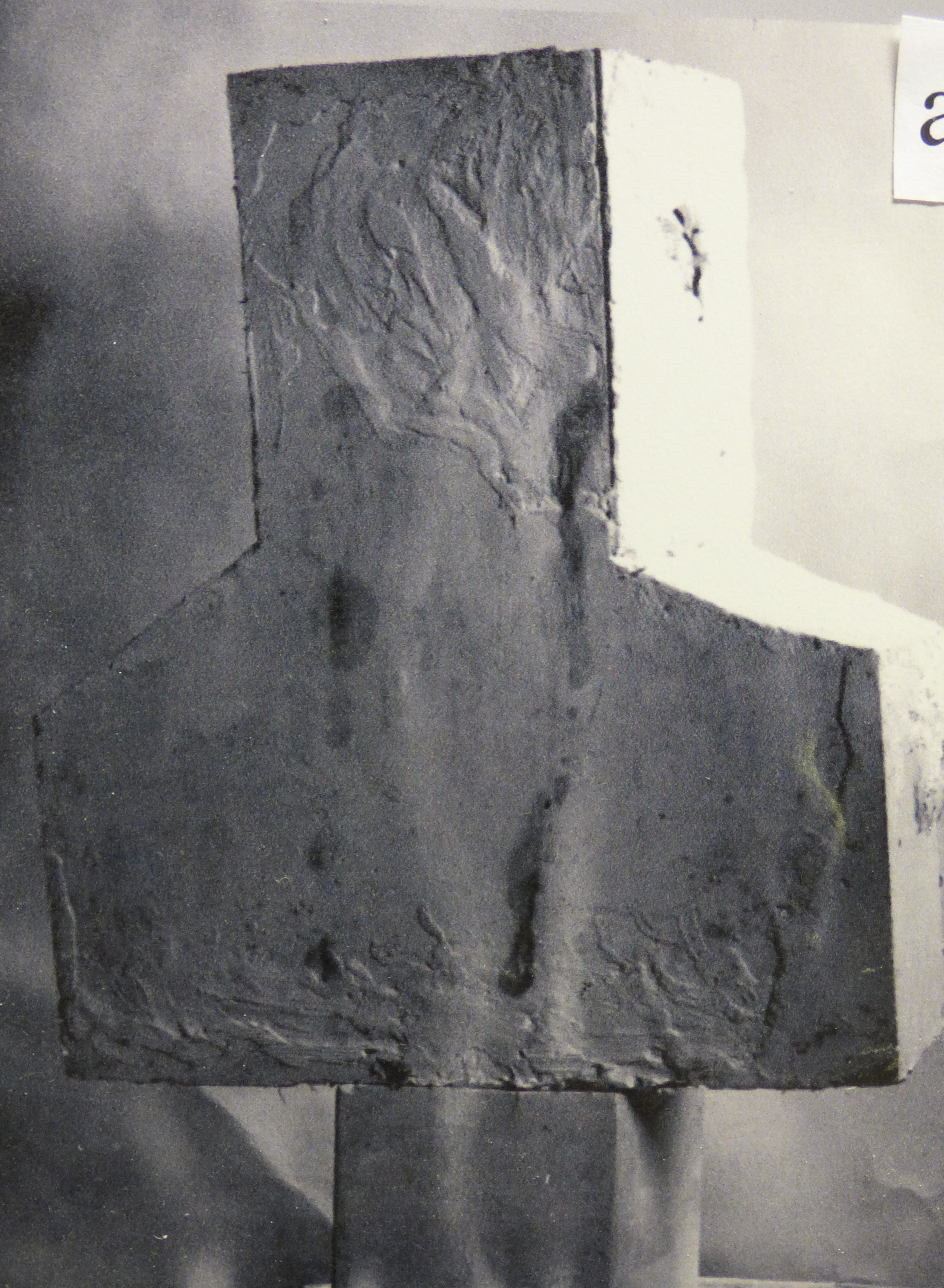
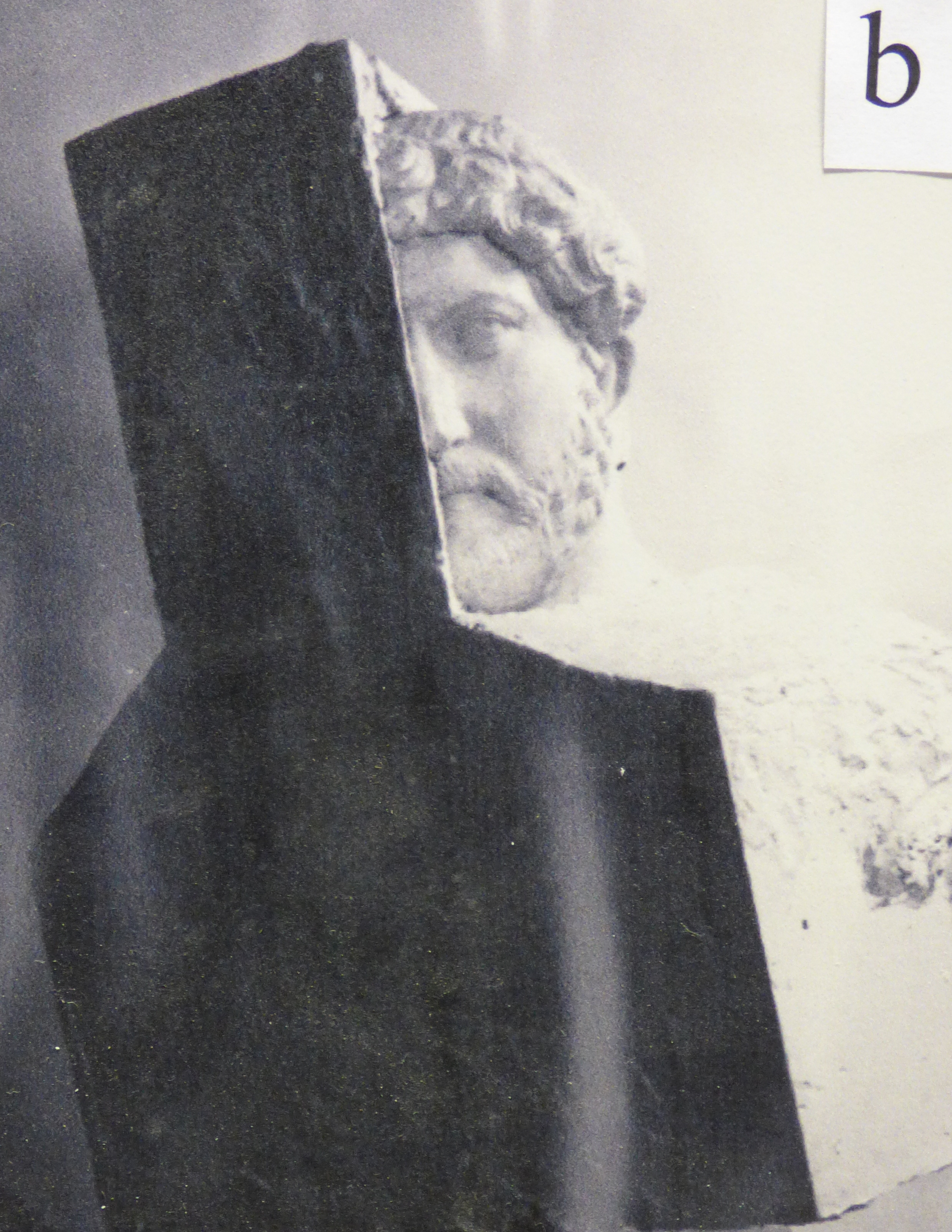
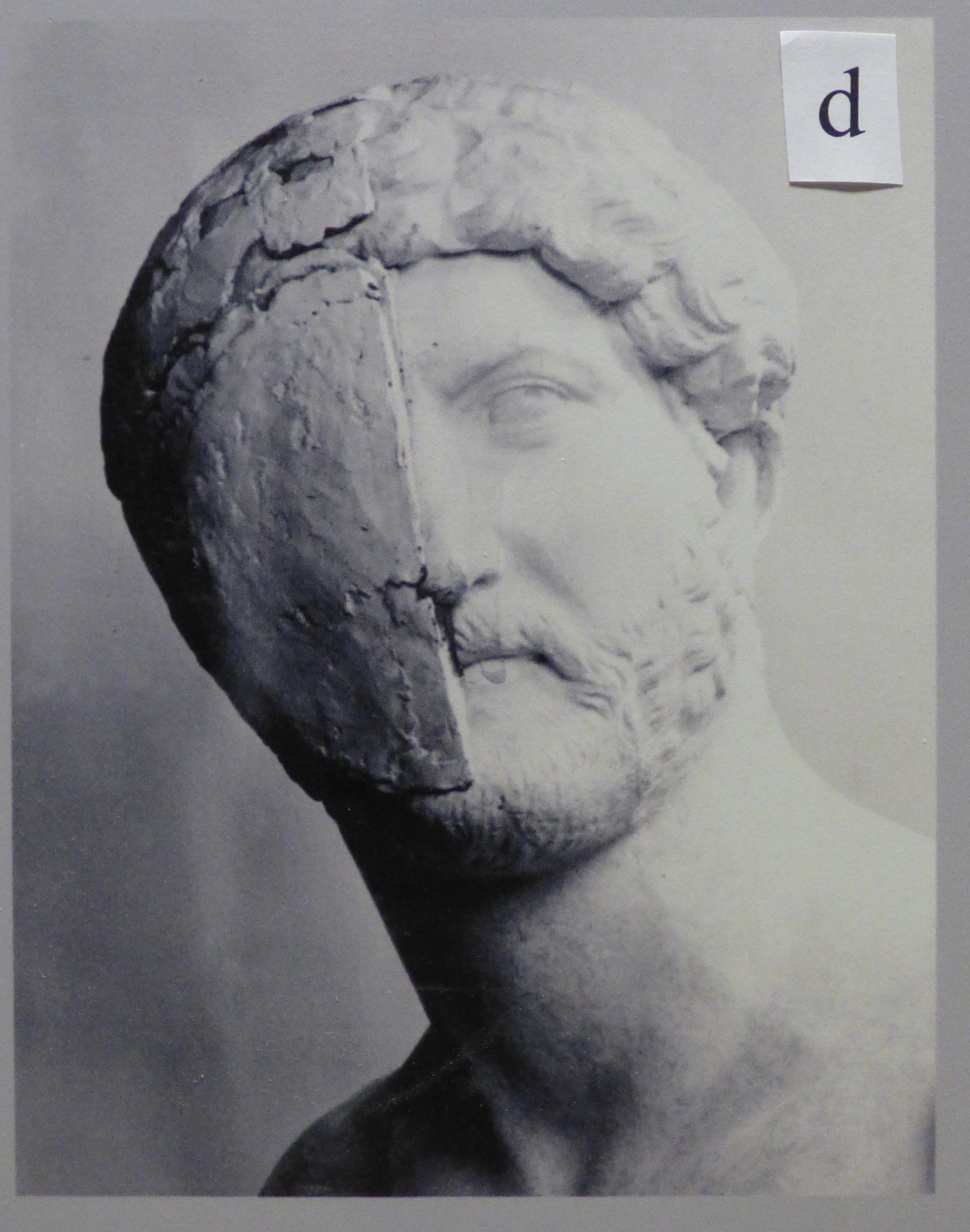
Fig. 23, 24, 25 (left to right) - First stages of the sculpting procedure. The dark plain is the front of the block of marble that contains the bust. It touches along the base of his chest and the central curl on the side of his wig. An apprentice has removed the unwanted stone above the shoulders then the axes of Hadrian's head are determined by the right edge of the block (the axis of symmetry) and joining the right top corner with that diagonally opposite (for the axis in depth).
The next two photographs (Fig. 26) are of the same moment in carving and show how the egg has been carved into with two wedge-shapes cut down from the measuring boss. The sculptor cuts down one side of the nose and across the front of his cheek with the first wedge and with the second he cuts under the curls and along the side of his face. Amusingly the sculptor went too far and chipped both ears just above the earlobe precisely in line with the curls. You see how these geometric shapes are still visible in the final sculpture (Fig. 27). Many copies from the same workshop still exist today. In The Uffizi he looks the other way and wears a toga but the method is the same.
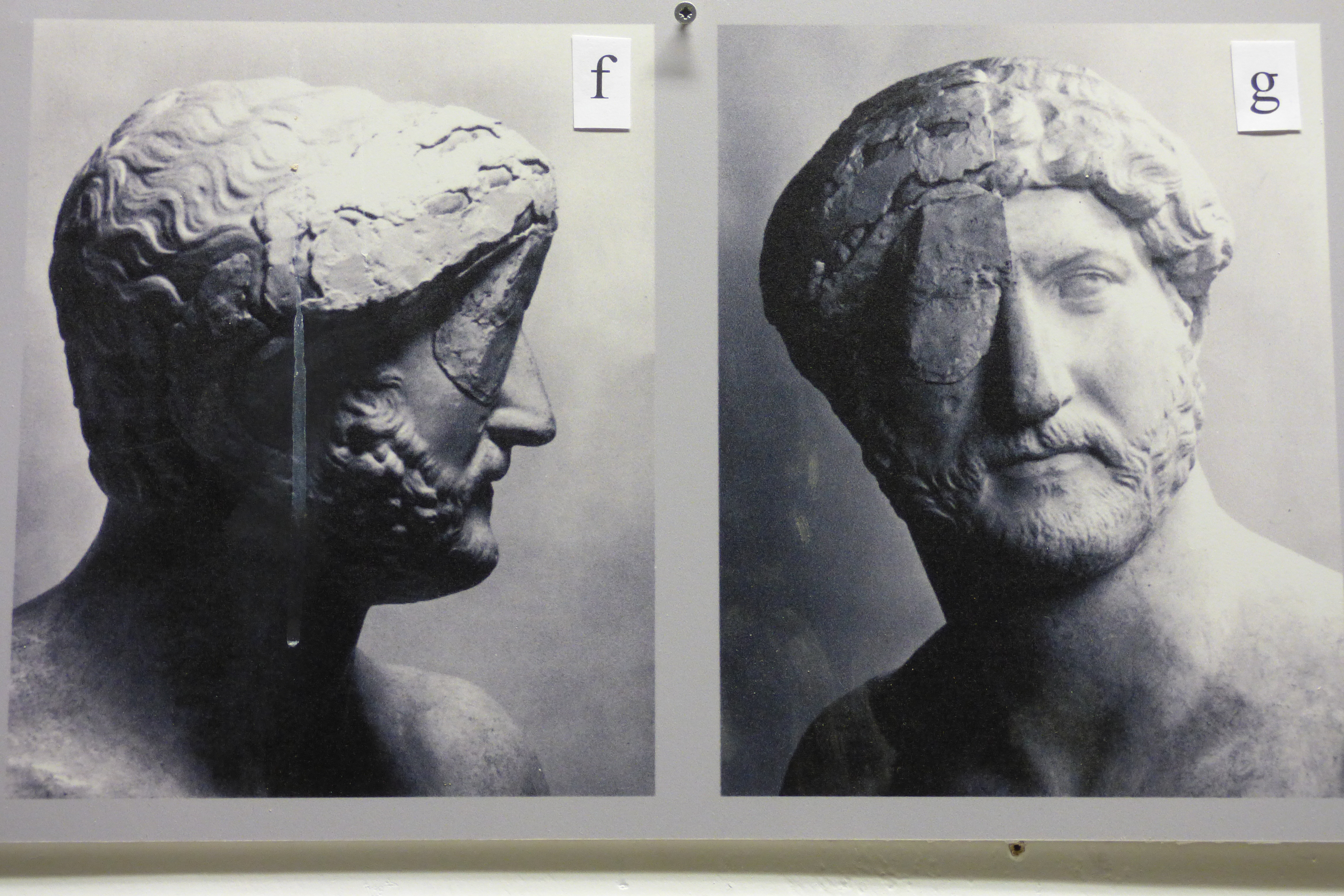
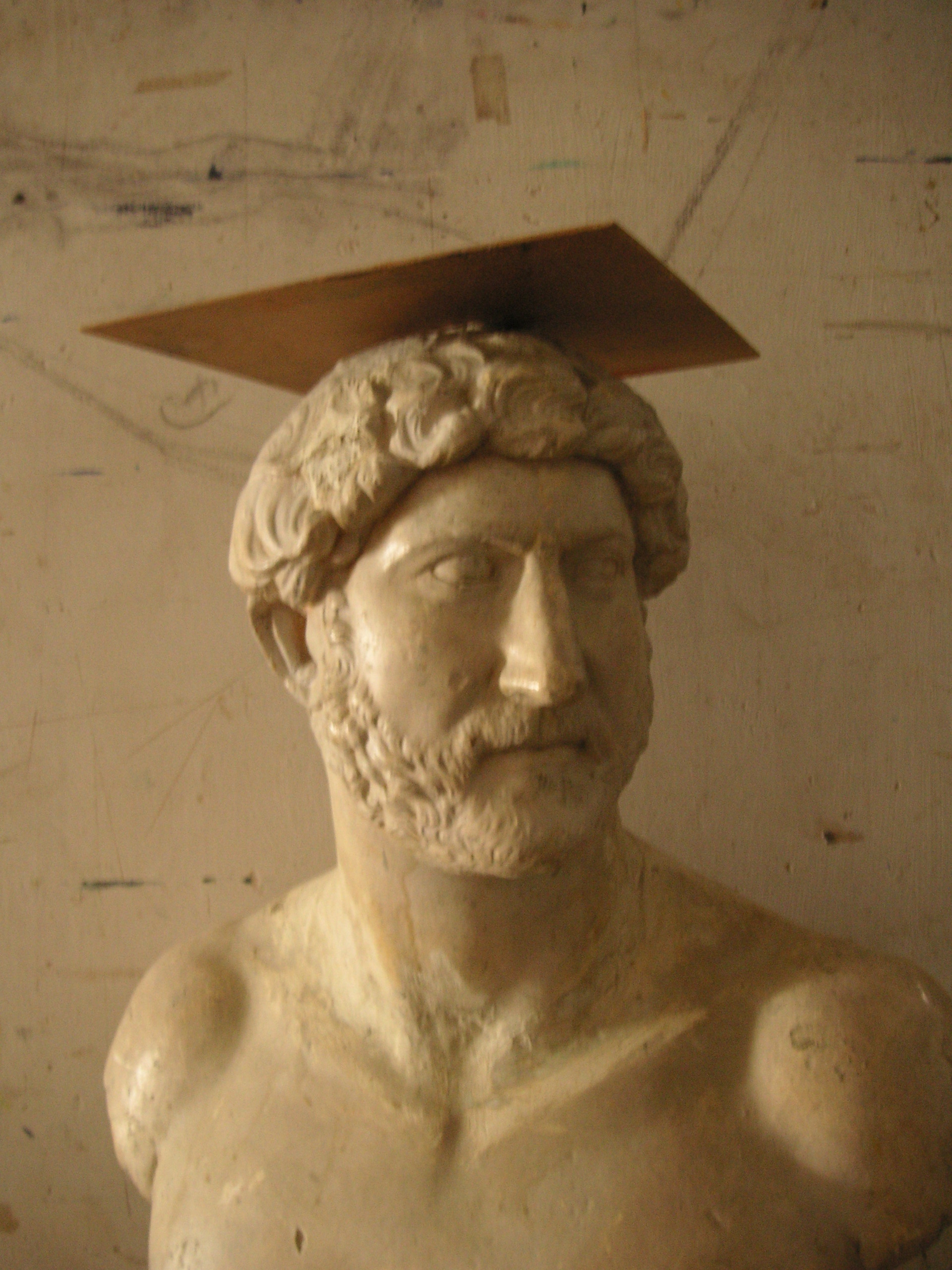
Fig. 26 (left) - Showing the carving of the egg into two wedges. Fig. 27 (right) - Bust of Emperor Hadrian The square above his head represents the top of the smaller block from which the head is derived. All the geometric forms - the block, the egg and the wedges are perfectly visible on the finished portrait.
The use of calipers for measuring the position of the widest points of Hadrian’s beard and of his curls and then cutting planes between them predisposes the sculptor to think in geometrical terms. In this case the sculptor so loves the geometry that the frown above the nose and the corners of the mouth below are precisely in the plane cut down from the boss (Fig. 27). He is emphasising the geometry and this three dimensional geometry has appealed to artists ever since. It is a vehicle for individuality where the Greek egg impedes individual portraiture.
The History of Art is largely the history of artists getting closer to nature. We look to the Greeks as having taken that great leap forward from their abstract beginnings (Fig. 28) – and then breaking the Archaic Egyptian mould (Fig. 29) that had dominated vision for nearly 3000 years and arriving at the more natural classical contrapposto (Italian for "counterpoise" - the weight of the figure is depicted as mostly on one leg) (Fig. 30) that has dominated the art of sculpture ever since.
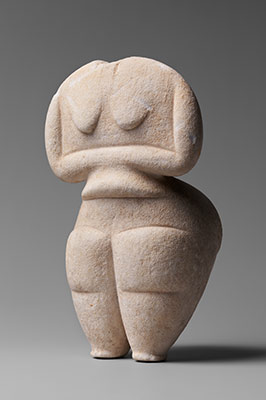
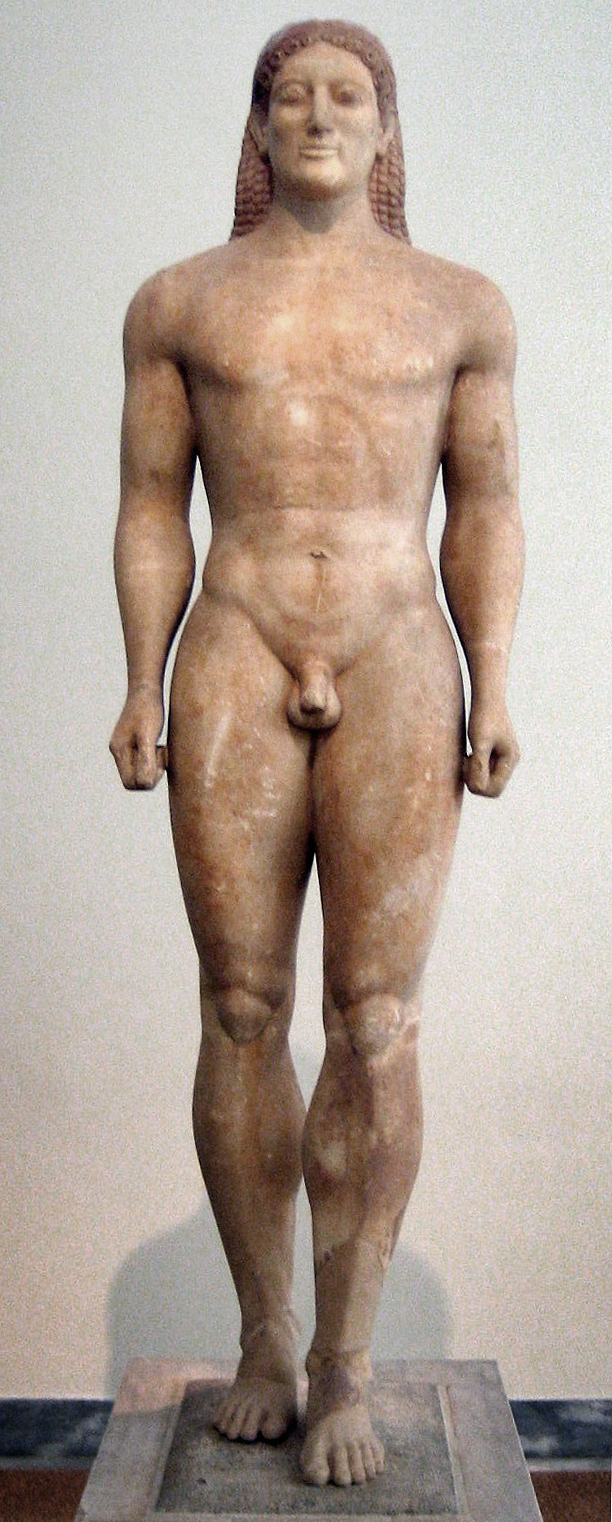
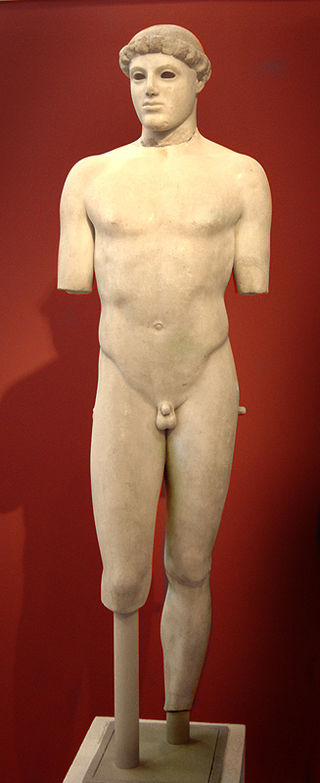
Evolution in artistic depictions (left to right) Fig. 28 - Early Greek Cycladic figure. Fig. 29 - Egyptian style Kouros figure c. 530 BC. Fig. 30 - Earliest known use of contrapposto by the ancient Greeks c. 480 BC.
This is where the history of European art begins. But the Greek miracle happened too quickly, between 500 & 470 BC. Where the same journey took the Renaissance Florentines at least four times as long to make the transformation from Nicola Pisano to Michelangelo. They had the advantage of plenty of Greek and Roman examples to guide them and we know that Leonardo and Michelangelo made many anatomical studies. There is no evidence that the Greeks did the same. The current story of the Greeks is hard to believe and through my scepticism I happened on an explanation that has proved taboo with the experts since.
I found a proof that the Bronzes of Riace (Fig. 31) were based on life-casting. My findings were published in The Oxford Journal of Archaeology in 2004 and have been ignored ever since. At the same time I discovered an industrial chimney 150 m upwind from the Parthenon (Fig. 32) evidently used by Phidias for melting his bronze. It was published in the same journal in 2002 and has met the same fate of neglect.
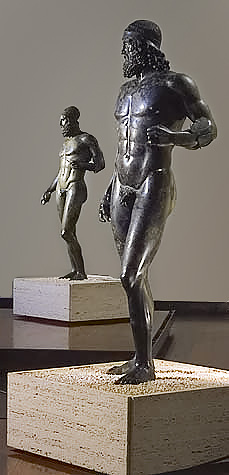
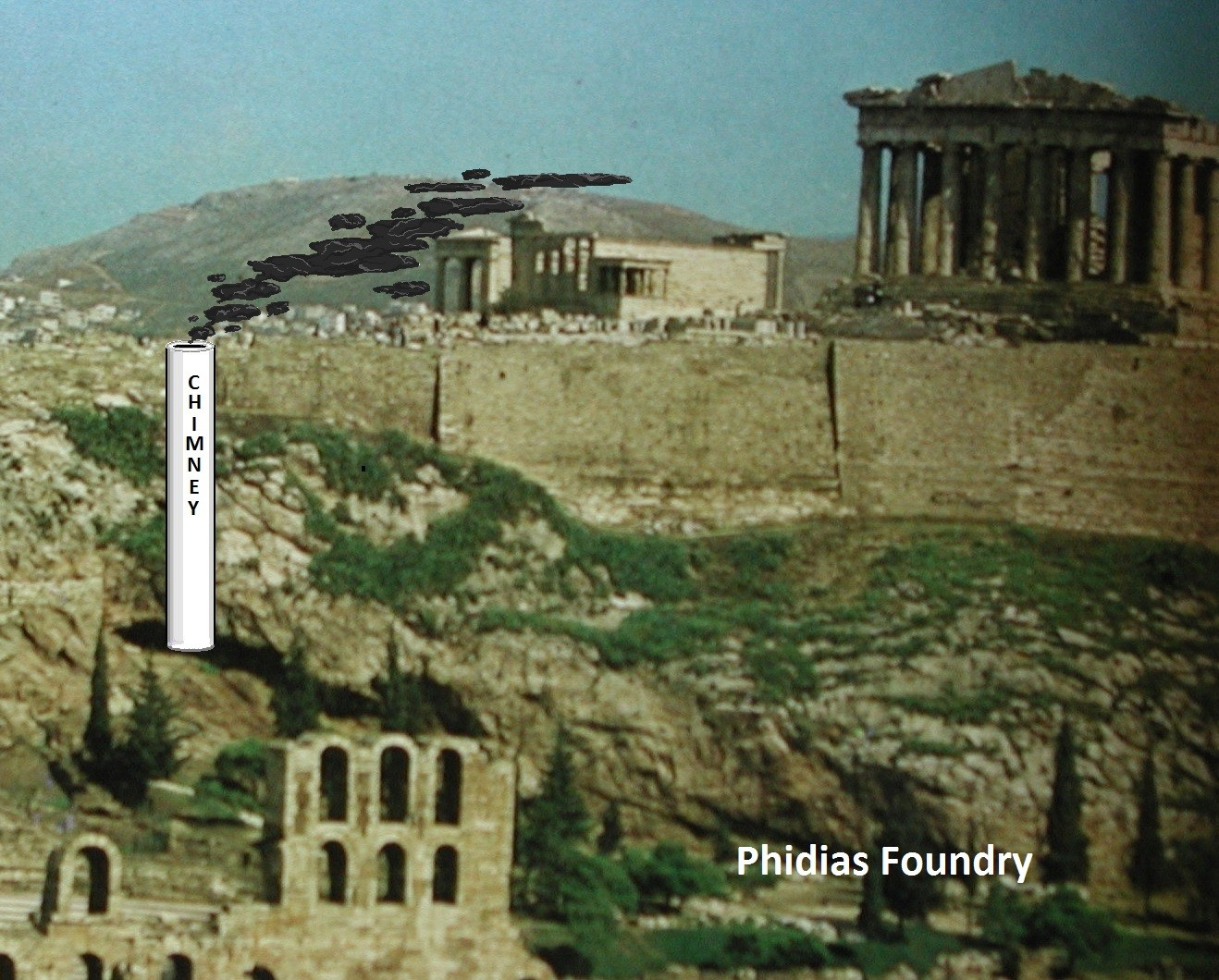
Fig. 31 (left) - Another view of the Bronzes of Riace. Fig. 32 (right) - Location of the the industrial chimney
These two discoveries led to a further discovery in 2017 which should one day shake the foundations of art history and criticism. It is that the Elgin Marbles are largely Roman restorations of the original Greek works damaged by 570 years of pollution from the chimney. I was forced to publish the evidence myself because neither the OJA nor the British Museum, where the evidence is its prize exhibit, would take responsibility. The experts are not keen to change the stories that their expertise depends upon. So far the younger generation have not stepped in to demand more true responsibility. May this essay change that!
The evidence is as plain as day when you come to it with the knowledge of where the pollution came from. The evidence can be appreciated by the untutored eye because it does not rest on style alone.
The original Greek work is all greyish in colour with black parts where the smoke came more directly through the building or where the carvers had to do more heavy work. In Classical times they were carving with fragile tools made of iron or bronze. This work was done by using the tools at right angles to the final surface, crumbling away the unwanted stone but the method also bruising the wanted stone beneath, creating micro fissures in the marble that allowed the sooty pollution to enter beyond the reach of the four vigorous cleanings they have suffered. The fissures have the effect of making the marble less shiny than the Roman. The Greek has also undergone more wear from weather.
Elgin Arguments
Photographs may confuse the shadows with the soot pollution so here is a guide to take on your next visit to the British Museum. There is also my booklet Elgin Arguments now available as an e-book and my book Sculpture, the Art and the Practice (2nd edition) (Fig. 33) which gives a full account of my two earlier Greek discoveries with diagrams and photos of the sculptural techniques involved.
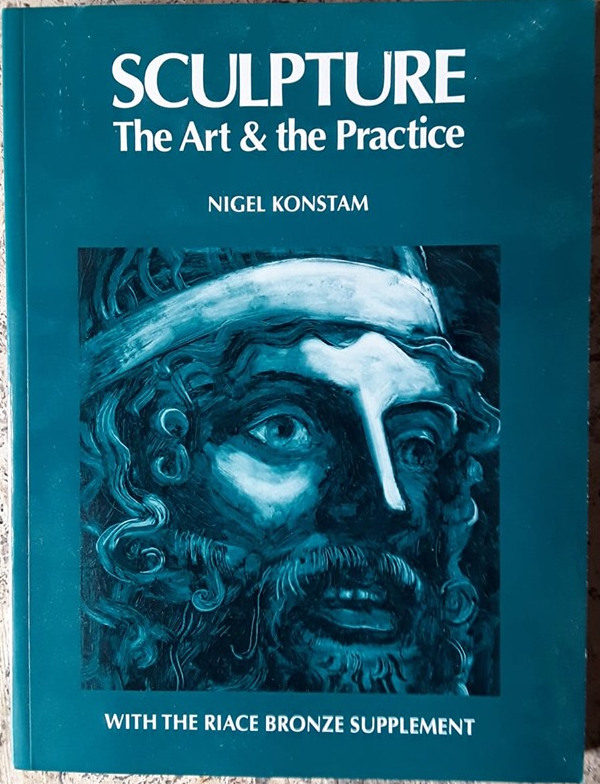
Fig. 33 - My book Sculpture, the Art and the Practice (2nd edition). Copies can be purchased by contacting me at This email address is being protected from spambots. You need JavaScript enabled to view it.
A guide to to distinguishing Greek from Roman work in the Elgin Marbles, I put no copyright on this description so please send it to anyone who might be interested and take it yourself when you next visit the British Museum. This description goes somewhat further than the original booklet as it compares and contrasts the South Frieze of the Elgin Marbles with the casts of the North Frieze which Elgin brought back leaving the originals in place, clearly, because they seemed less good. I now believe that the South frieze is mainly Roman restoration as well as the west pediment, both were most probably commissioned by the Emperor Hadrian (117 – 138 AD) that is 570 years after Phidias designed the originals. They are not restorations in the modern sense because they are improvements on the original work. The Horse of Selene and the west pediment has been preferred by a series of connoisseurs thinking it was Greek. Richard Payne Knight the one connoisseur who recognised the Roman work at the time Elgin was selling them to the government was disgraced for his heresy.
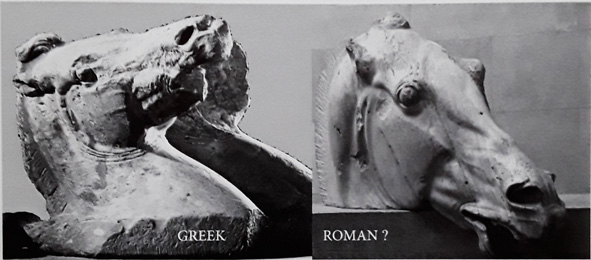
Fig. 34 - The horses of Selene (right) and Helios (left)
The horse of Selene on the east pediment is Roman (Fig. 34). It is easily distinguished because the original work is blackened by smoke and the Roman is clean shiny marble, furthermore it is in much better condition as it has not been subjected to 570 years of weather and smoke. Compare the horses of Helios with the horse of Selene (Fig. 34), both on the east pediment but they could not be by the same author or from the same date; Selene is markedly better and has become the icon of the Elgin collection, though it is Roman.
This reassessment of the relative quality of Greek and Roman work matters because many of the great masters of the past are much more reliant on Roman geometric form than is now acknowledged – Masaccio, Mantegna, Holbein, Rembrandt, Degas and Giacometti for example (see above).
All are based on Roman three dimensional geometry and their achievement cannot be properly understood by present critical methods. Geometric relationships are not read by sensitive lines but by the turning of plains. Art historians have paid too little attention to the important Roman contribution to European art, it is less ideal more individualised, truer to life.
It is clearly very difficult for archaeologists to admit to centuries of failure to see what is now so obvious. This is why I need public support on social media. Left to themselves the experts have shown no willingness to reform.
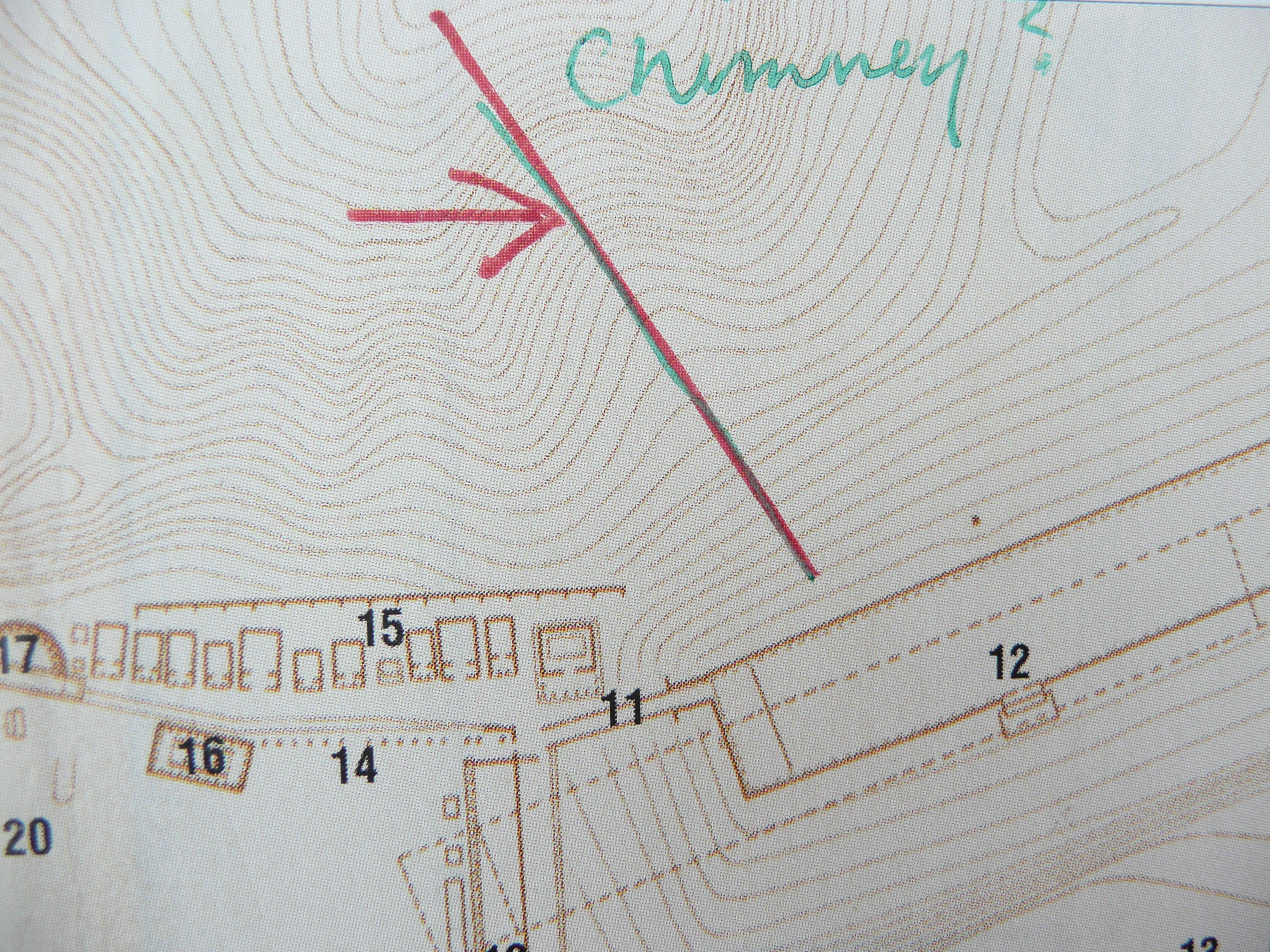
Fig. 35 - A second chimney used by Phidias at Olympia is visible in the contours of the hill of Kronos and confirmed by the fact that three furnaces were found at its base (see also Fig. 32)
A New Tour of the Elgin Marbles
by Nigel Konstam (sculptor & art detective)
No copyright
This tour is designed to demonstrate that European Art History is based on an understandable error: the greater part of The Elgin Marbles, all of which were taken off of The Parthenon, are nonetheless Roman not Greek. Furthermore, connoisseurs have regularly preferred the Roman work to the Greek. This idea was first proposed by Richard Payne Knight when Elgin was selling the sculptures that he had saved from the ruins of The Parthenon to the government. Payne Knight was disgraced for his heresy but Konstam brings new evidence of an industrial chimney 150 m upwind from the west facade (Fig. 35), the pollution from which could have so damaged the sculptures that they needed to be restored, probably by Hadrian (117-138 AD). The chimney was discovered by Konstam in 2000 and in spite of his efforts no carbon test has been done on its soot or tar. Such tests could confirm or deny his theory as there is still plenty of black on the original Greek sculpture to compare. This needs to be done.
1. Start at the east pediment viewed from afar. Note how all the sculptures (Fig. 36) are grey with some black in places. The black is mainly coming from below but the black is also in deeply carved pockets where more bruising of the stone has taken place (Fig. 37). This is due to the use of simpler, fragile iron or bronze tools at right angles to the surface, which bruises the marble. This bruising allows the black smoke to enter so deeply into the stone, that no cleaning can shift it. This is genuine Greek Classical work. The exception is the horse of Selene (See Fig. 34) on the extreme right which I believed to be Roman and carved with steel tools at an angle to the surface which does not bruise the finished stone. The Selene Horse really looks like marble and is most admired. All are the same Pentelic marble though they do not look the same. Note also that the quality of the carving is superior to that of the Helios pair (Greek) (See Fig. 34).
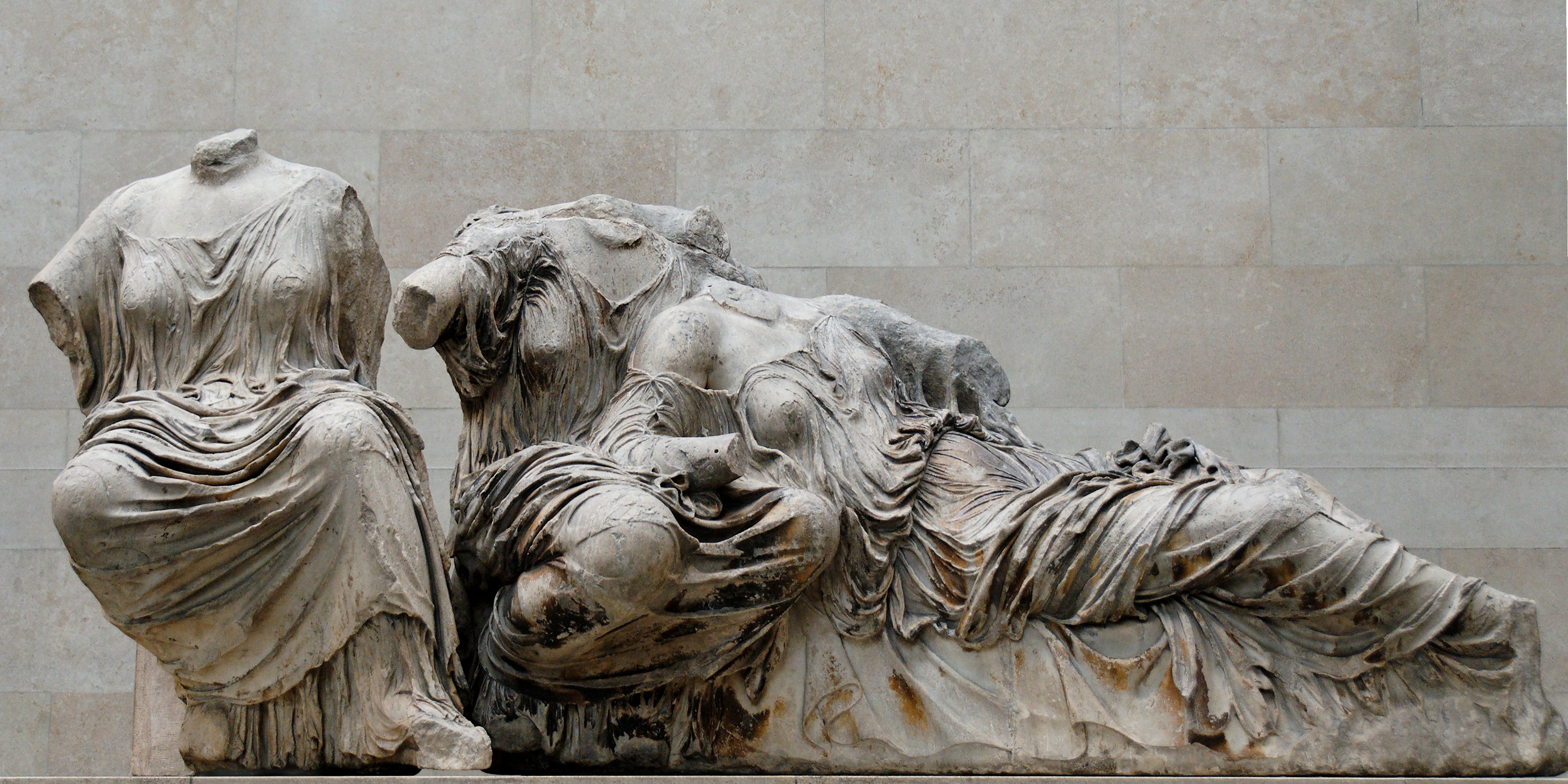
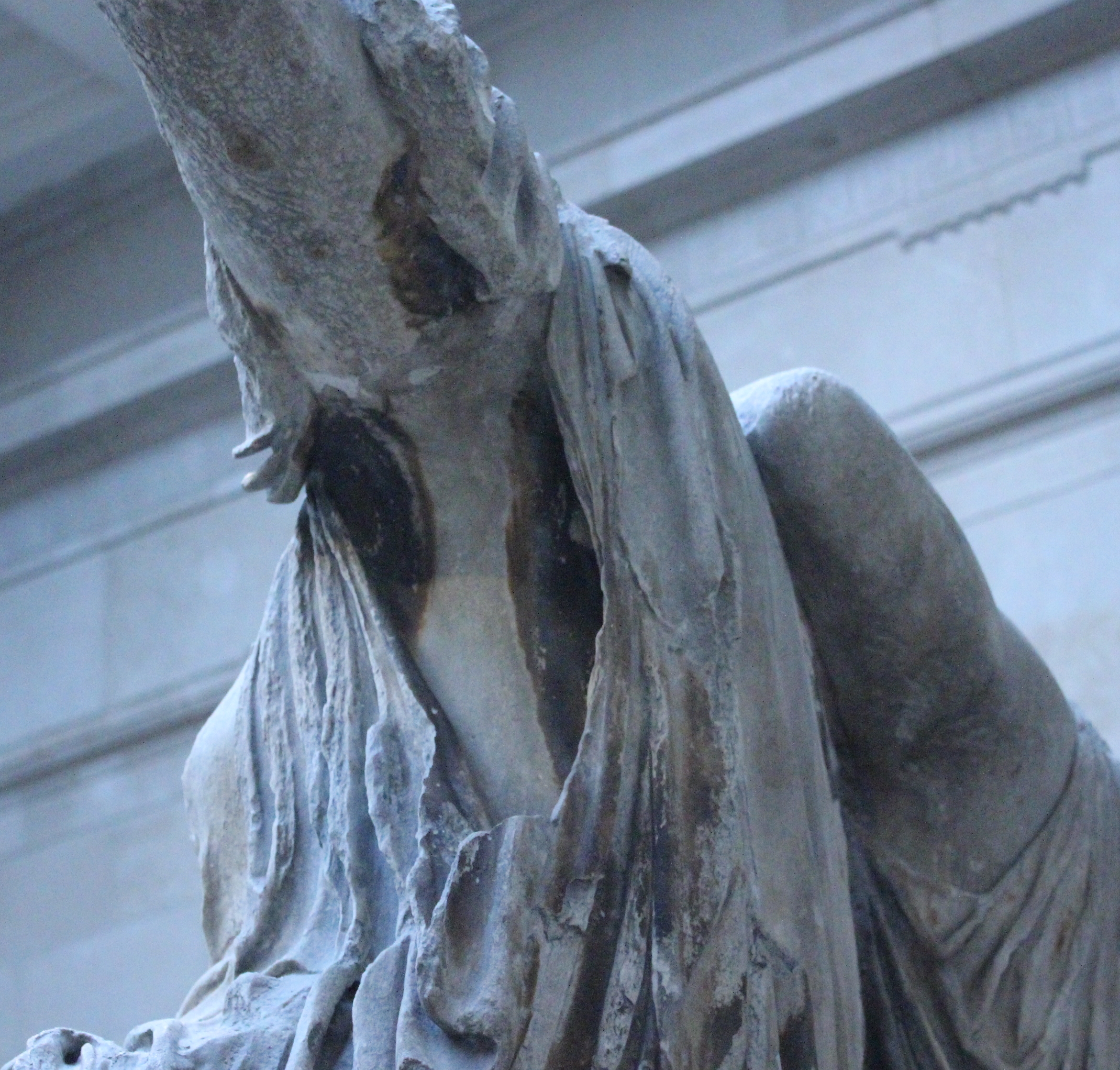
Fig. 36 (left) & Fig. 37 (right) - Blackening of sculptures on the eastern pediment
2. Move closer to the two horses of Helios on the left. Note the one behind has lost his muzzle, note how weathered and soft the break is. This is because the break is very old. (We will see the west pediment damage is much newer.)
3. Look under the knee of Dionysus (Fig. 38), the next figure to the Helios horses, you will find areas of black particularly where it overhangs the parapet. Look very carefully and you will find a declivity where the smoke has eaten away the stone under the actual knee bones, note also how narrow the knee has become, possibly because the underside has been reworked as a makeshift repair of the smoke damage.
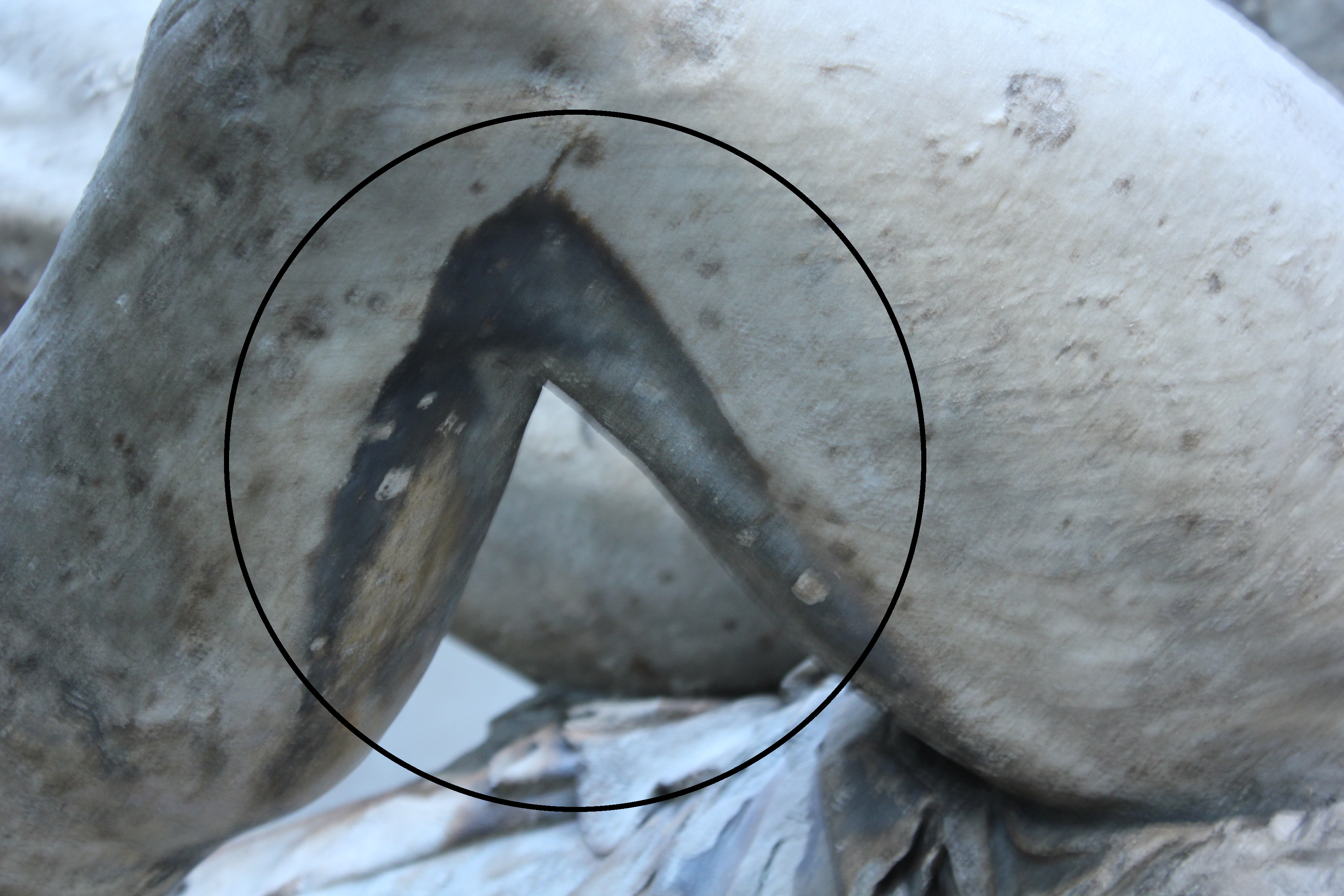
Fig. 38 - Blackening under the knees of the statue of Dionysus in the Parthenon
There is also evidence that this figure was copied from a life-cast (Fig. 39) in hollow wax such as was used to cast the Bronzes of Riace (see The Oxford Journal of Archaeology 2002 or Sculpture the Art and the Practice for details): the carver has copied so accurately the crude modification made to bend the figure to this new pose that this use of casts, much more practical than a live model, is strongly indicated. It accounts for the miraculous speed with which the Greeks moved from archaic to classical naturalism: in around 30 years.
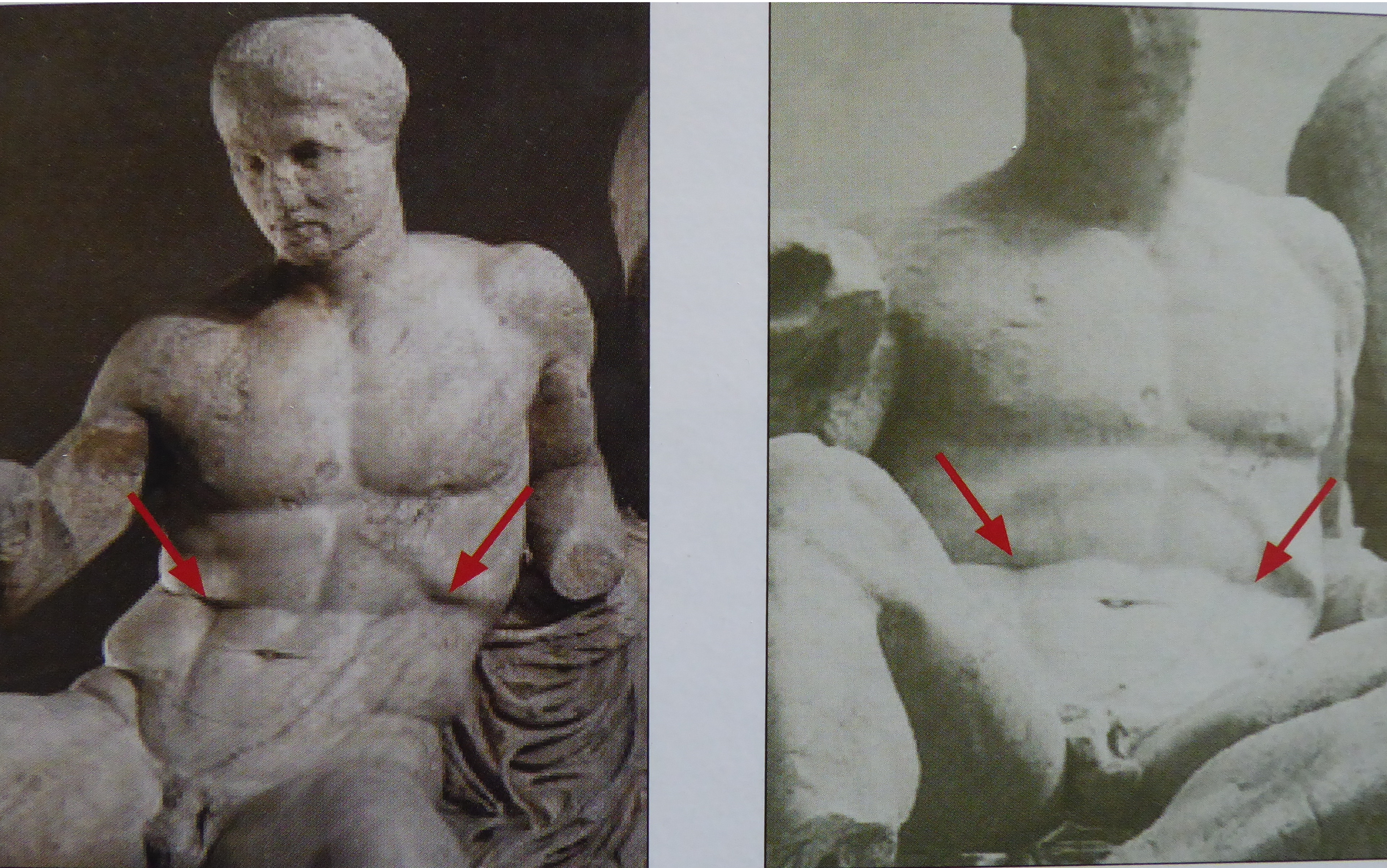
Fig. 39 - Creases in the stomach of the statue of Dionysus, suggesting a wax life casting method.
4. Note the black on the lower skirts of the two ladies next to Dionysus (Fig. 40). All you have seen so far would have received the smoke collected by the south colonnade as it is in line with these sculptures and is where the smoke would naturally escape, driven by a SW wind. The rest of the pediment is somewhat less blackened because farther from the main stream of smoke.
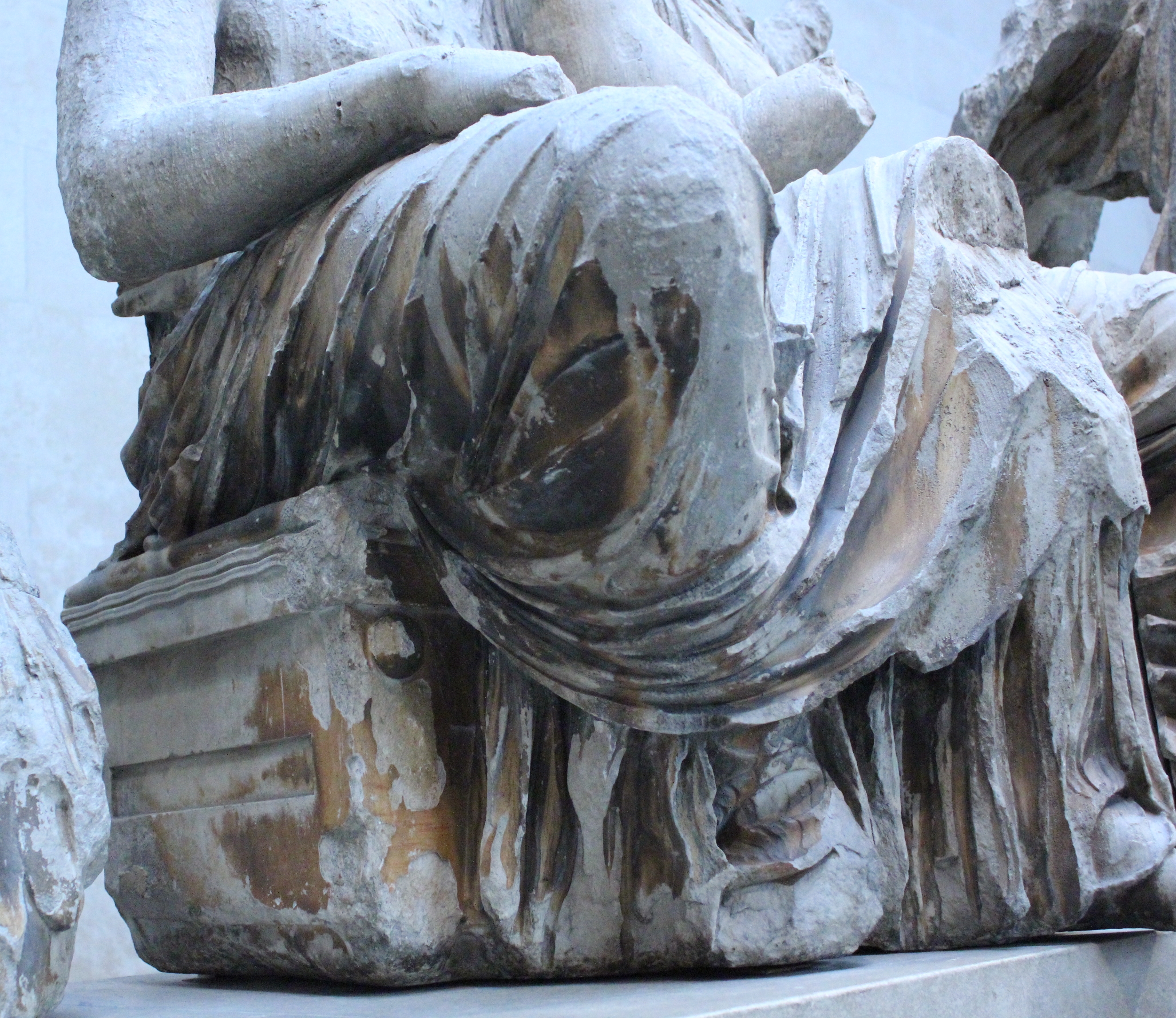
Fig. 40 - Blackening of the skirts of a figure near the Dionysus statue.
5. Continue to note grey colouring until you reach the horse of Selene, far right; clean and quite clearly of Roman origin. The original Greek version would have been furthest from the source of smoke but it would have received that smoke direct in its mouth and nostrils which overhang the parapet and would have been extra vulnerable because of the extra bruising caused by excavating those hollows with iron or bronze tools.
6. Round the back of the east pediment you will note the extra blackening in the deepest holes or valleys explained as above (See Fig. 37). If this amount of damage was done by smoke here think how much more was done to the west pediment much closer to the chimney plus more direct rain. An early photo (Fig. 41) made 2000 years after the pollution shows most blackening on the west facade.
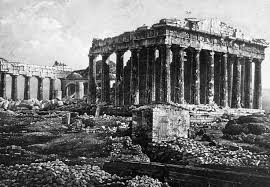
Fig. 41 - Early photograph of the Parthenon (1839)
7. As you walk towards the west pediment note the sophistication of the relief carving where sometimes the depth of 3 figures overlap. Some of the horses heads do not work that well because they have not sufficient depth of stone but the bodies are very well adapted to the varying depth of space they occupy. This is Roman, if you wish to see the true Greek relief of the classical period go next door to the Xanthos room there you will see very beautiful reliefs but much simpler. Between these major displays you will see the plaster casts of the northern frieze which Lord Elgin chose to leave in Athens; these are less good Greek reliefs. I have called them naive because the awkward art of relief is no longer following the earlier rules and has not yet worked out the new ones. Block 4 is a particularly crude example of this. Where the Roman horses in the main gallery are remarkably uniform, real cavalry horses, these horses vary from overblown roundabout horses to rather deer-like forms, nor is the anatomy well understood. Opposite this room you will find an excellent video of the arrangement of the south frieze in cavalry ranks indicating yet more Roman sophistication.
8. At the west pediment note all is clean and the surface marble-like (Fig. 43) because carved with steel tools. The steel tools held at an acute angle to the surface when cutting, do not bruise the stone. The earlier crumbling method (Greek) with iron tools uses the tool at right angles to the surface that bruises the finished stone as well. The bruising allowed the soot to enter so deeply into the stone that even the brutal cleaning of 1938 could not shift it. The finished surface of this earlier carving would have been polished with abrasives but could not have reached the shiny surface of the Roman work.
It is probable that Hadrian closed down the foundry if it had not been closed before. Any dirt on the west pediment is the result of ageing. The grave damage is much crisper (Fig. 44) than that of the Helios horses probably because it is younger, caused by Venetian canon during the bombardment of 1687.
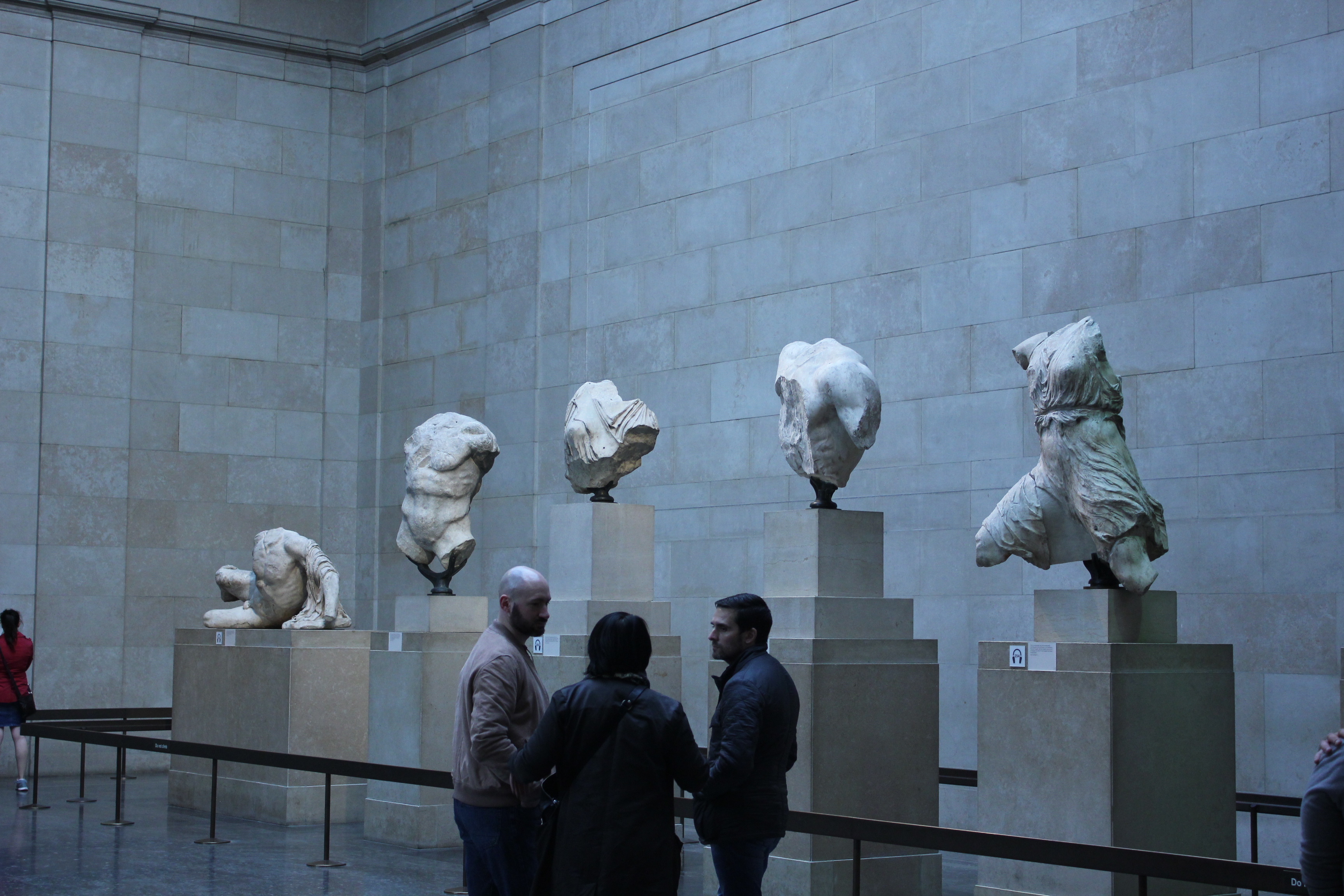
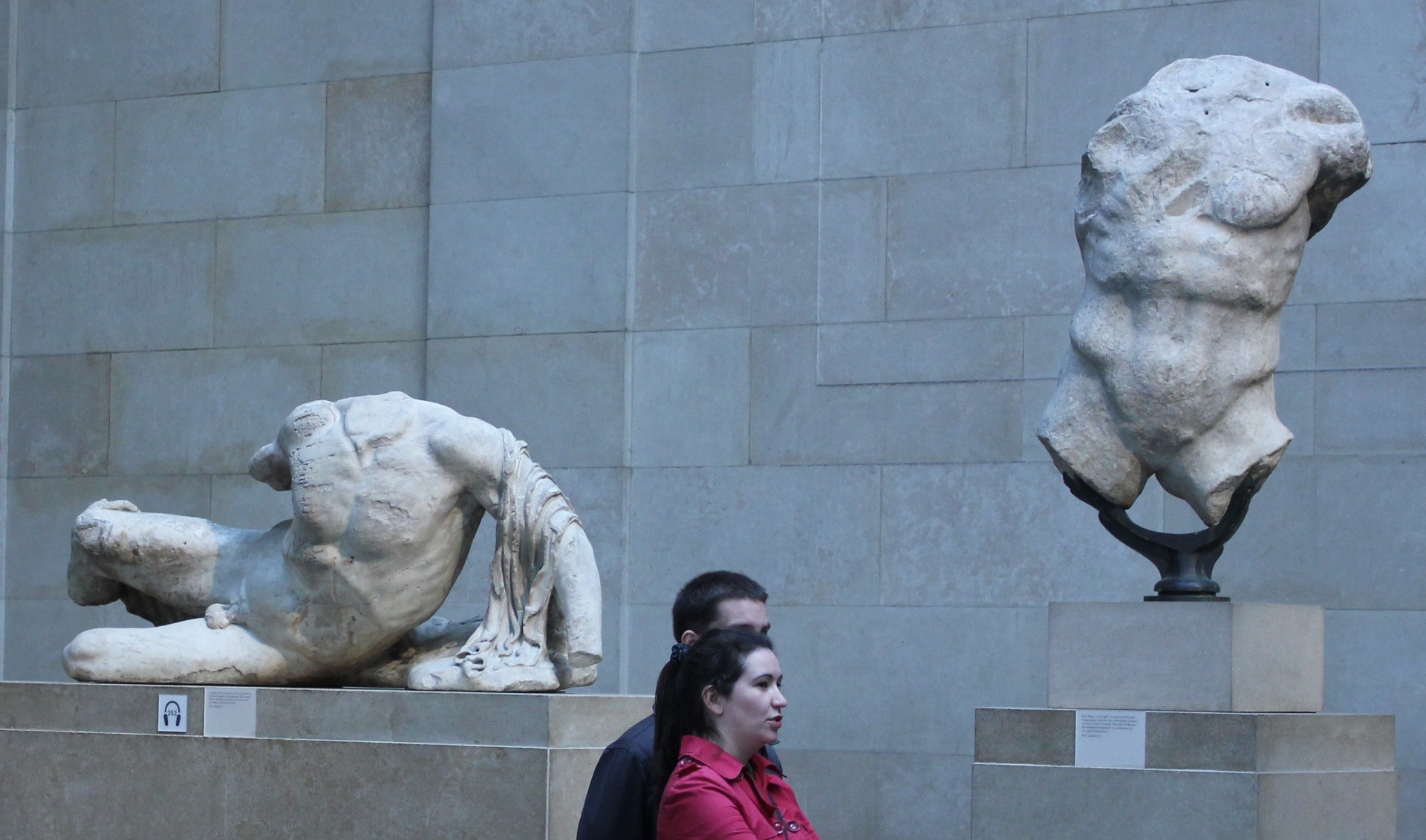
Fig. 43 (left) & Fig. 44 (right) - Sculptures from the western pediment of the Parthenon.
These numerous anomalies seen in the colour, texture, style and weathering can be best explained by severe damage done by the Phidian chimney before 117 AD and subsequent restorations probably ordered by Hadrian.
I think I have won the argument on the front-cover of the booklet Elgin Arguments where I contrast the Horse of Selene with the Horses of Helios, both from the east pediment of The Parthenon. Selene is Roman in shiny marble and beautifully carved and the Helios pair are Greek and artistically much less satisfying.
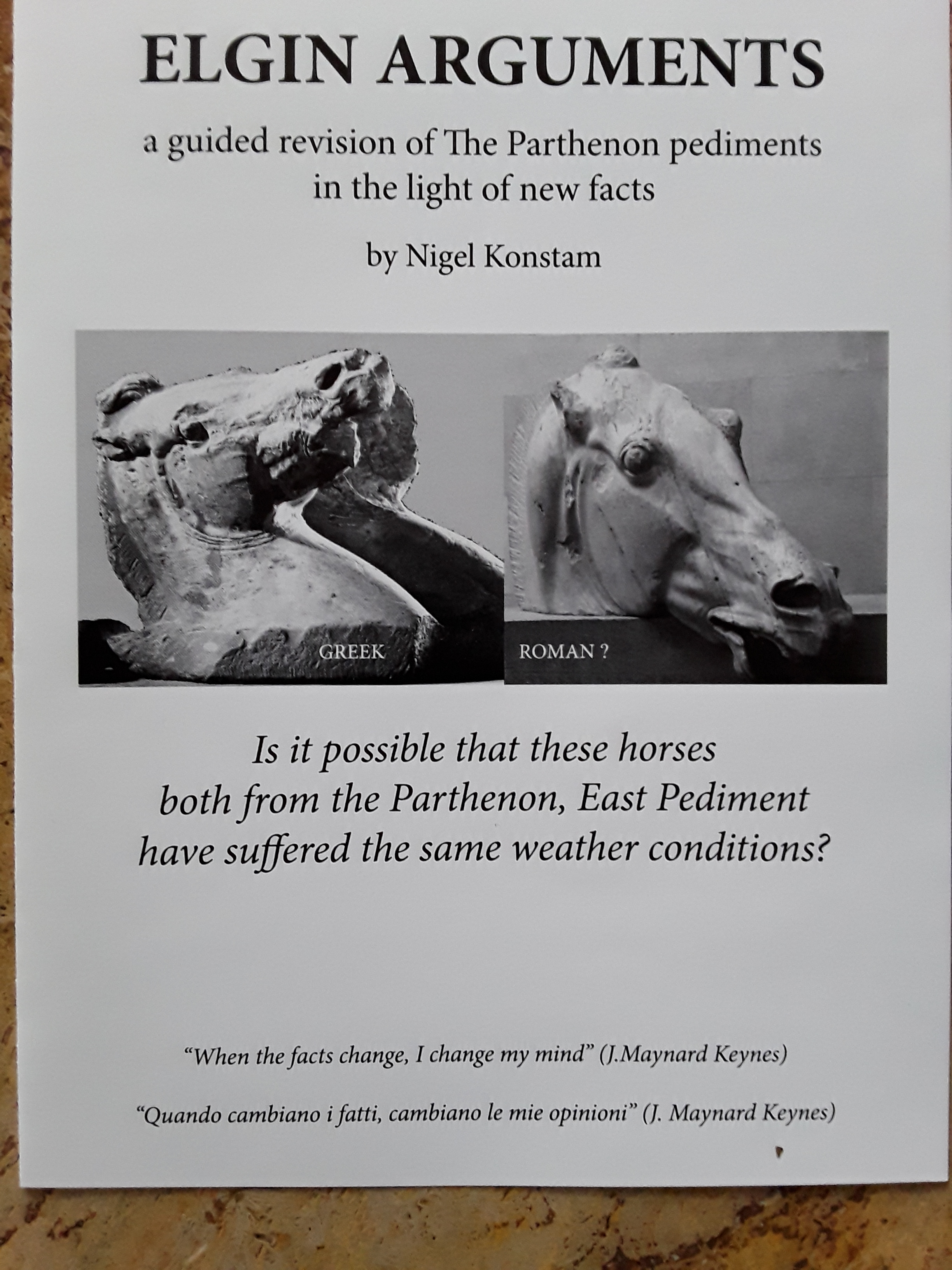
Fig. 45 - Cover of the Elgin Arguements booklet available here [coming soon] you may also wish to watch this YouTube video.
Thank you for following me this far; please go one step further and support my call for change in art history on social media.
